Vick's Co-Defendant Agrees
to Plea Deal
By Michael S. Schmidt
 THE
NEW YORK TIMES, RICHMOND, Va., - One of the men indicted with
Michael Vick on federal dogfighting charges pleaded guilty Monday
and has agreed to help prosecutors make their case. THE
NEW YORK TIMES, RICHMOND, Va., - One of the men indicted with
Michael Vick on federal dogfighting charges pleaded guilty Monday
and has agreed to help prosecutors make their case.
Tony Taylor, a 34-year-old
from Hampton, Va., pleaded guilty here in United States District
Court to charges of conspiring to travel in interstate commerce
in aid of unlawful activities and to sponsoring "a dog in
an animal fighting venture."
Taylor, Vick and two other
men, Purnell A. Peace, 35, of Virginia Beach; and Quanis L. Phillips,
28, of Atlanta, pleaded not guilty last week in the case. But
as part of his deal, Taylor signed a 13-page statement that confirmed
much of what the government asserted in its indictment of the
men on July 17.
Taylor outlined his involvement
with the others in a dogfighting enterprise known as Bad Newz
Kennels, according to the statement. He attested to how he scouted
a property for Vick to buy in Smithfield, Va., as the base for
the venture and cited numerous examples in which the group bought,
trained and sponsored dogs in connection with fighting. He also
said they gambled on the fights.
Although the statement said
several dogs were killed, it did not say that Vick killed any
of them. The statement said Taylor had a falling out with Phillips
in 2004 and had not been part of the enterprise since.
The 18-page indictment against
the men accuses them in graphic detail of animal cruelty. During
a search of Vick's property in April, 54 pit bulls were recovered,
along with a so-called rape stand used to hold dogs in place
for mating, an electronic treadmill modified for dogs, and bloody
carpeting. As part of his agreement with prosecutors, Taylor
is expected to give testimony that mirrors his statement.
Since being indicted on charges
of sponsoring, gambling on and authorizing acts of cruelty against
dogs, Vick has had his football career put in limbo - and in
jeopardy. N.F.L. Commissioner Roger Goodell told him not to attend
training camp, Reebok has pulled his Atlanta Falcons jerseys
from stores, and Nike has stopped sales of its Vick-branded products.
At a 9 a.m. hearing Monday,
Taylor stood with his lawyer, Stephen Ashton Hudgins, before
Judge Henry E. Hudson and answered questions about whether he
understood the plea agreement.
Taylor responded that he did
with brief answers in a deep monotone voice.
He faces up to five years in
prison and a $250,000 fine, and is free on bond while awaiting
a Dec. 14 sentencing. Because a trial in the case has been scheduled
for Nov. 26, the judge and prosecutors will have time to evaluate
the extent of Taylor's cooperation before setting a punishment.
Vick and the others are also
free on bond.
Daniel C. Richman, a professor
at Columbia Law School and a former assistant United States attorney,
described the plea agreement as an important step for the investigation.
"A witness like this is
the only way to really get inside information without tracking
the crime while it is happening," Richman said. "This
is the government's way of signaling to the other defendants
that it has significant evidence and that they should seriously
consider pleading guilty themselves."
A spokeswoman for the United
States attorney's office in Richmond declined to comment because
the investigation was still under way.
Vick's lawyer, Billy Martin,
did not return a telephone message seeking comment.
While leaving the court Monday,
Taylor was swarmed by reporters who peppered him with questions
about Vick.
Taylor said nothing as he entered
a waiting car and left.
Carl Tobias, a professor at
University of Richmond Law School, said that the turn of events
did not help Vick but that defense lawyers could attempt to discredit
Taylor.
"Vick's lawyer was saying
on Thursday that they were going to fight this thing to the end,
but just a few days later someone has already pled," Tobias
said. "There is a lot time between now and the trial, and
the other defendants could turn as well. But the other three
of them may be hanging together. They could go after Taylor's
credibility by citing the falling out as more motivation to turn
against them."
Hear
Dogfighting in America with HSUS John Goodwin.
Sports Illustrated Michael Vick Poll
Hear breaking news as it happens - Animal Radio®
is streaming online 24/7 Listen LIVE Now!
This Week on Animal Radio®:
Wendie Malick (Nina
Van Horn on Just Shoot Me)
 Wendie Malick was a presenter at the 21st Genesis
Awards, which is an annual event to honor outstanding individuals
in the major media for raising awareness of animal issues presented
by The Humane Society of the United States. Wendie Malick was a presenter at the 21st Genesis
Awards, which is an annual event to honor outstanding individuals
in the major media for raising awareness of animal issues presented
by The Humane Society of the United States.
 This year's award, which took place
on March 24th at the Beverly Hilton in Beverly Hills, California.
The full ceremony is being re-broadcast on AmericanLife TV. This year's award, which took place
on March 24th at the Beverly Hilton in Beverly Hills, California.
The full ceremony is being re-broadcast on AmericanLife TV.
Listen
in as Wendie talks
about growing up with dogs, and in fact, states her older sister
was a collie!
http://www.arktrust.org
 Hear
Wendie Malick on Animal Radio® Hear
Wendie Malick on Animal Radio®
Next Week on Animal
Radio®:
John Tartaglia
 Broadway
and TV star John Tartaglia ("Avenue Q," "Johnny
and the Sprites") has volunteered to spread the word about
pet adoptions and is now a spokesperson for The Humane Society
of the United States' Proud 2 Adopt campaign. The New
York-based actor shares his home with four of his own shelter-adopted
pets. Broadway
and TV star John Tartaglia ("Avenue Q," "Johnny
and the Sprites") has volunteered to spread the word about
pet adoptions and is now a spokesperson for The Humane Society
of the United States' Proud 2 Adopt campaign. The New
York-based actor shares his home with four of his own shelter-adopted
pets.
The HSUS offers Proud 2 Adopt
"care packages" at no charge to new "pet parents"
who send in their adoption certificate from their local shelter
or rescue group. The package includes: an HSUS certificate, a
P2A t-shirt, bumper sticker, pin, pen, brochures, and a coupon
for Hill's Science Diet pet food. Information about getting the
free package can be found at http://www.humanesociety.org/adopt
 Tartaglia
stated, "I believe that there is no organization as powerful
and knowledgeable about animal issues as The HSUS and it's an
honor to be linked with them on this project. I consider my own
dog Dora and cats, Sebastian, Mia and Keisha all from shelters
to be part of my family, and I am a proud dad to have them
in my life." Tartaglia
stated, "I believe that there is no organization as powerful
and knowledgeable about animal issues as The HSUS and it's an
honor to be linked with them on this project. I consider my own
dog Dora and cats, Sebastian, Mia and Keisha all from shelters
to be part of my family, and I am a proud dad to have them
in my life."
Tartaglia, best known for his
Tony Award-nominated performance on Broadway in the original
cast of "Avenue Q," is star, executive producer and
co-creator of the hit Disney Channel series "Johnny and
the Sprites." As a puppeteer, he was one of the youngest
actors to ever appear on "Sesame Street," where he
worked for 10 years starting at the age of just 16. In addition,
he appeared earlier this year as Lumiere on Broadway in "Beauty
and the Beast."
RECENT Animal Radio® PODCASTS:
 Podcast LUCIE ARNAZ - Growing up with
Lucie & Desi (1 hour abridged version) Podcast LUCIE ARNAZ - Growing up with
Lucie & Desi (1 hour abridged version)
Podcast
WENDIE MALICK - Her dog was her babysitter.
Podcast
DR. DEBBIE WHITE - Anti-Depressants for your cat.
 Podcast DOGFIGHTING IN AMERICA with
HSUS's John Goodwin. Podcast DOGFIGHTING IN AMERICA with
HSUS's John Goodwin.
Podcast
TRAVELING WITH YOUR PET Special with HGTV's CLIVE
PEARSE.
Podcast
CHRISTOPHER AMERUOSO photographs
pets and their celebrity owners. Find out what celeb he proposed
to.
Recently on Animal
Radio®:
Lucie Arnaz
 Lucie
Arnaz was one of the first members of Actors and Others for Animals
when they opened their doors. This comes as no surprise, as she
is the daughter of Lucille Ball and Desi Arnaz, who were big
animal lovers themselves. Lucie grew up around all types of animals,
from rabbit and ducks and once even had a boa constrictor. Her
father, Desi Arnaz, once owned and operated a thoroughbred breeding
farm called Corona Breeding Farm of thoroughbred horses. Lucie
Arnaz was one of the first members of Actors and Others for Animals
when they opened their doors. This comes as no surprise, as she
is the daughter of Lucille Ball and Desi Arnaz, who were big
animal lovers themselves. Lucie grew up around all types of animals,
from rabbit and ducks and once even had a boa constrictor. Her
father, Desi Arnaz, once owned and operated a thoroughbred breeding
farm called Corona Breeding Farm of thoroughbred horses.
Lucie currently does not have
any pets, as she lost her 2 dogs and her 2 cats to friend when
she went to Europe for a year and a half and upon her return
didn't have the heart to uproot her pets who had become used
to their new people and surroundings.
Lucie began her career at age
12 when the played in her mother's tv show "The Lucy Show,"
and then she became a series regular on "Here's Lucy"
co-starring with her brother, Desi Arnaz, Jr. But despite her
many movie credits, Lucie's real passion lies in lived theatre.
 Hear
Luci Arnaz on Animal Radio® Hear
Luci Arnaz on Animal Radio®
Traveling With Your Pets Special
 Dogs are the pets that travelers
bring along most often, according to the Travel Industry Association.
It estimates that 29 million travelers have taken a pet with
them at least once in the past three years. The group said 78
percent of those people (about 22.6 million) took dogs, while
feline travelers were a very distant second. Cat owners made
up 15 percent of the pet-toting public (about 4.4 million). Dogs are the pets that travelers
bring along most often, according to the Travel Industry Association.
It estimates that 29 million travelers have taken a pet with
them at least once in the past three years. The group said 78
percent of those people (about 22.6 million) took dogs, while
feline travelers were a very distant second. Cat owners made
up 15 percent of the pet-toting public (about 4.4 million).
This annual special covers
the new products and services available for your traveling pets.
Top 10 Fido Friendly Destinations
Susan Sims of Fido Friendly Magazine counts down the top
10 places to take your pet.
 10.
Four
Paws Kingdom Campground in NC 10.
Four
Paws Kingdom Campground in NC
Campers will enjoy the 33 acre campground where owners can swim
with their dogs and where you can sign your dog up for obedience
and agility during your stay.
 9.
Cunard Lines'
Queen Mary 2 9.
Cunard Lines'
Queen Mary 2
Bet you didn't think you could cruise with Fido but for you world
travelers out there, the good news is you can! The Queen Mary
2 makes the transatlantic crossing in 6 days. There are just
12 kennels on board as dogs are not allowed inside your rooms.
The cost to take your dog ranges from $300-$500 one way.
 8. The
Ruby
at Crested Butte, CO 8. The
Ruby
at Crested Butte, CO
The Ruby is the premier Fido friendly bed and breakfast in the
very dog friendly town of Crested Butte. Each dog that stays
at this bed and breakfast will lap up the luxury as much you
will.
 7.
Cambria
Shores Inn, Cambria, CA 7.
Cambria
Shores Inn, Cambria, CA
Newly renovated upscale accommodations right across from the
ocean; you receive your breakfast in a basket on a hook outside
your door and Fido receives his own goody basket as well. $15.00
pet fee.
6. Cypress Inn, Carmel, CA
 Carmel is one of the top FF cities
in the country where pets can run leash-free on Carmel Beach.
The Cypress Inn, owned by actress and animal activist, Doris
Day, gives you a list of Fido-friendly restaurants where you
can dine al fresco with your dog and offers pet-sitting. $30
and up for pet fees. Carmel is one of the top FF cities
in the country where pets can run leash-free on Carmel Beach.
The Cypress Inn, owned by actress and animal activist, Doris
Day, gives you a list of Fido-friendly restaurants where you
can dine al fresco with your dog and offers pet-sitting. $30
and up for pet fees.
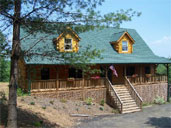 5.The
Dog
House Resort, NC 5.The
Dog
House Resort, NC
Listed as a B&B for people and their dogs, this is a brand
new property on 3 acres overlooking the Blue Ridge Mountains.
There is no pet fee or breed restrictions and there is a fenced
dog park on property. You can also canoe or walk with your dog
at the nearby New River. Great place to plan a fall foliage trip.
 4.
Bar-N
Ranch, West Yellowstone, MT 4.
Bar-N
Ranch, West Yellowstone, MT
Located just 10 minutes from the entrance to Yellowstone National
Park, the Bar N Ranch offers private, Fido Friendly cabins on
over 200 acres. The breakfast is included and is out of this
world. You and Fido are free to romp on the 200 acres or fish
in the river running through the property. Pet fee is $15.00
for 2 dogs.
 3.
Las
Ventanas al Paraíso, A Rosewood Resort in Baja, Mexico 3.
Las
Ventanas al Paraíso, A Rosewood Resort in Baja, Mexico
Here is a great pick for those adventurous souls venturing south
of the border. Upon arrival, dogs receive a neck massage and
while you relax poolside, your canine companion can relax right
along side you inside his own pet cabana. The down side is it's
a bit pricey at $450 a night and $50.00 pet fee.
2. Arizona Biltmore, Phoenix, AZ
 As part of the Biltmore's "Preferred
Pet Pals" program, the hotel sends guests who are bringing
pets a special profile to complete before arrival, noting everything
from size to special dietary needs. Several of the Biltmore's
cottages feature enclosed yards for dog play, and the 39-acre
resort has other large common grassy areas for all guest pets
to enjoy. Room-service pet meals come with Arizona Biltmore bottled
water. $250 deposit; $200 of which is refundable As part of the Biltmore's "Preferred
Pet Pals" program, the hotel sends guests who are bringing
pets a special profile to complete before arrival, noting everything
from size to special dietary needs. Several of the Biltmore's
cottages feature enclosed yards for dog play, and the 39-acre
resort has other large common grassy areas for all guest pets
to enjoy. Room-service pet meals come with Arizona Biltmore bottled
water. $250 deposit; $200 of which is refundable
1. Telluride, CO
 With it's pet-friendly gondola
and 2 dogs per person ratio, Telluride Colorado makes our Fido
Friendly top ten list coming in at number 1. No matter the season,
the resort town of Telluride rolls out the welcome mat for you
and your dog. With puppy parking stations located throughout
town, you can leash Fido up with some of his new best friends
while you run errands or dine. There is a dog park in town and
you will see several well-behaved pooches walking off-leash with
their guardians. The whole town is Fido-friendly and there are
too many Fido-friendly hotels to mention. Just take my word for
it, this is a travel destination for you and your dog you won't
want to miss. With it's pet-friendly gondola
and 2 dogs per person ratio, Telluride Colorado makes our Fido
Friendly top ten list coming in at number 1. No matter the season,
the resort town of Telluride rolls out the welcome mat for you
and your dog. With puppy parking stations located throughout
town, you can leash Fido up with some of his new best friends
while you run errands or dine. There is a dog park in town and
you will see several well-behaved pooches walking off-leash with
their guardians. The whole town is Fido-friendly and there are
too many Fido-friendly hotels to mention. Just take my word for
it, this is a travel destination for you and your dog you won't
want to miss.
And if I do have to mention
two of my favorites, they are The Peaks Resort, home to the famous Golden
Door Spa. There is a Fido entrance to the spa where your dog
will be pampered while you hit the slopes or are getting pampered
at the same time. $150 non-refundable fee. Each additional pet
is $50. And the Mountain Lodge at Telluride. The hotel's "Elevated
Pooch Package" includes dog bed, check-in biscuits, a take-home
dog dish and copy of "Fido Friendly." With a two-night
stay they'll waive the $25 per night pet fee.
Don't miss Fido Friendly Travel Talk on Animal Radio®
Check out Fido Friendly at: http://www.fidofriendly.com
Animal Radio's
Traveling with Your Pet Special brought to you by DryFur, makers of the Dryfur pet carrier
insert; and KURGO,
makers of innovative products to safely restrain your dog while
traveling.
 Traveling with
Your Pet Special on Animal Radio® Traveling with
Your Pet Special on Animal Radio®
Is There an Easier Way to
Medicate Pets?
Dr. Marty Becker
 Transdermal delivery of medications
to veterinary patients is becoming increasingly popular. The
transdermal gel is simply rubbed into the pet's inner ear, delivering
an active agent or a combination thereof in a controlled form.
The transdermal gel technology controls the delivery of the active
agent over periods of time ranging from 12 to 24 hours. The extent
of the controlled release window enables a once-a-day application. Transdermal delivery of medications
to veterinary patients is becoming increasingly popular. The
transdermal gel is simply rubbed into the pet's inner ear, delivering
an active agent or a combination thereof in a controlled form.
The transdermal gel technology controls the delivery of the active
agent over periods of time ranging from 12 to 24 hours. The extent
of the controlled release window enables a once-a-day application.
The transdermal route is desirable
in many patients, including those animals with behavioral problems
that makes handling and administering oral medications difficult;
animals whose health is compromised and the stress of oral administration
would further aggravate medical conditions; and any animal whose
owners are unable to "pill" or administer oral medications
to their pet.
 There
are also "VetChews"
in which the raw drug is compounded into a chewable treat base
form, or you can find a pharmacy which offers flavored liquid
medication. There
are also "VetChews"
in which the raw drug is compounded into a chewable treat base
form, or you can find a pharmacy which offers flavored liquid
medication.
Hear Dr. Becker talk about the different
ways to administer medications to our pets.
http://www.DrMartyBecker.com
http://www.PetConnection.com
 Hear
Dr. Marty Becker on Animal Radio® Hear
Dr. Marty Becker on Animal Radio®
Therapy Kangaroo
Noralynn Snow, Silverado
Senior Living Community
 You've probably heard of therapy
dogs and cats, and even perhaps horses and pigs. But what about
a Kangaroo? Well, residents of the Silverado Senior Living Community
have the pleasure of visits from Elliott, a six-month old baby
Kangaroo. You've probably heard of therapy
dogs and cats, and even perhaps horses and pigs. But what about
a Kangaroo? Well, residents of the Silverado Senior Living Community
have the pleasure of visits from Elliott, a six-month old baby
Kangaroo.
Elliot visit the 120 citizens
of the center, who suffer from everything from Alzheimer's disease
to Parkinson's disease, and will even sit on their laps for hours
at a time.
 It
has been proven that animals of all types can have large health
benefits. Dr. Marty Becker, author of The Healing Power of
Pets states that "there is actually a biochemical event
that happens when they come in contact, a biochemical spa treatment
of sorts and that "it lowers blood pressure and elevates
the mood." It
has been proven that animals of all types can have large health
benefits. Dr. Marty Becker, author of The Healing Power of
Pets states that "there is actually a biochemical event
that happens when they come in contact, a biochemical spa treatment
of sorts and that "it lowers blood pressure and elevates
the mood."
When Elliot is not at the hospital,
he goes home with a staff member, Noralynn Snow, and actually
sleeps in bed with her.
http://www.silveradosenior.com
 Hear Noralynn Snow on Animal Radio® Hear Noralynn Snow on Animal Radio®
Pets and Their Celebrities
Christopher Ameruoso
 Armed with a mantra of "Just
Do It", Christopher Ameruoso has carved himself a unique
and successful niche in the Hollywood Hills where dreams are
made and stars are born. Gaining access to some of Hollywood's
most sought-after stars, armed only with an artistic eye an his
camera, Ameruoso has become a self-made photographer of Pets
and the stars that own them. He has been photographing actors,
actresses, and models since 1998, and has released a best selling
pet book "Pets and Their Celebrities". Armed with a mantra of "Just
Do It", Christopher Ameruoso has carved himself a unique
and successful niche in the Hollywood Hills where dreams are
made and stars are born. Gaining access to some of Hollywood's
most sought-after stars, armed only with an artistic eye an his
camera, Ameruoso has become a self-made photographer of Pets
and the stars that own them. He has been photographing actors,
actresses, and models since 1998, and has released a best selling
pet book "Pets and Their Celebrities".
Over the years Christopher
has been involved with a vast range of projects, including 'The
Osbournes pets' and 'Bark at the Moon', the official Osbourne
Family Pet Book. Christopher was tapped for a special tribute
to the search and rescue dogs of 9/11 for 'New Yorker' magazine
featuring nine celebrities with hero canines.
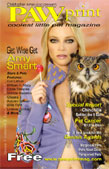 Throughout
the course of his career Christopher's work has been featured
in People magazine, In Style, Smoke, Star, US Weekly, The New
York Times, Daily News, The NY Post, and The LA Times to name
a few. In fact, People Magazine broke tradition and printed a
unique black and white montage of some of Christopher's select
pieces. Throughout
the course of his career Christopher's work has been featured
in People magazine, In Style, Smoke, Star, US Weekly, The New
York Times, Daily News, The NY Post, and The LA Times to name
a few. In fact, People Magazine broke tradition and printed a
unique black and white montage of some of Christopher's select
pieces.
He can now be seen every week
in 'In Touch' in his column titled 'Stars and Their Pets'.
Christopher Ameruoso has also
launched an animal lover's magazine 'PAW print'. After years
of photographing a myriad of celebrities and their beloved pets.
Christopher tells Animal
Radio® that George Clooney wouldn't let him
photograph him with his pig. Only one photo is in existence of
Clooney and his Swine.
http://www.ChrisAPhoto.com
http://www.PawPrintMag.com
 Hear Christopher Ameruoso on Animal
Radio® Hear Christopher Ameruoso on Animal
Radio®
Thunderstorms and Your Pet
Mike Fry, Animal
Ark Animal Shelter and Host of Animal Wise Radio with Dr. Linda
Wolf
 My first dog, a German Shepherd
named Buddy, was a beautiful, intelligent, perfect companion.
That is for one slight problem. He turned into a lunatic during
thunderstorms. And I don't mean just huddling in a corner, but
knocking over full-sized sofas in an attempt to get his 90-pound
frame behind one, My first dog, a German Shepherd
named Buddy, was a beautiful, intelligent, perfect companion.
That is for one slight problem. He turned into a lunatic during
thunderstorms. And I don't mean just huddling in a corner, but
knocking over full-sized sofas in an attempt to get his 90-pound
frame behind one,
So why do so many animals have
storm phobias? Animal senses are much sharper than ours. They
hear, smell and sense things with a clarity that we can hardly
imagine.
 Hear
Dr. Linda Wolf on Animal Radio® Hear
Dr. Linda Wolf on Animal Radio®
Bicycling
With Your Dog
 Mike Fry, Animal Ark Animal Shelter
and Host of Animal Wise Radio with Dr. Linda Wolf Mike Fry, Animal Ark Animal Shelter
and Host of Animal Wise Radio with Dr. Linda Wolf
If you think your dog
likes to tag along with you while you ride your bike think
again, especially in this hot weather. Most dogs aren't built
for this type of exercise, but will go along with you because
they want to be in your company and will do anything to please
you.
 Hear
Dr. Linda Wolf on Animal Radio® Hear
Dr. Linda Wolf on Animal Radio®
Rent-A-Pet Program
Seth Sachson, Aspen/Pitkin
Animal Shelter
 Moving to Aspen in 1992, Seth
Sachson was hired as the director of the shelter in 1993, and
in 1994 took over the contract to operate the shelter. In the
past 9 years, Seth has turned the shelter into a happy, healthy
atmosphere for animals and people alike. Moving to Aspen in 1992, Seth
Sachson was hired as the director of the shelter in 1993, and
in 1994 took over the contract to operate the shelter. In the
past 9 years, Seth has turned the shelter into a happy, healthy
atmosphere for animals and people alike.
One of the programs Seth has
started is the Rent-A-Pet Program. This program allows visitors,
who have been forced to leave their pets at home, the opportunity
to fill the void by spending a day outside the shelter with one
of the animals who live there. The program is also open to residents.
Other programs Seth has started
are:
Dog Walking Program
Recognized by the American
Humane Association as one of the top 100 animal shelter programs
in the United States, Aspen's dog walking program provides a
way to ensure that shelter dogs get plenty of exercise and human
interaction. As many as twelve volunteers come by the shelter
each day specifically to take a dog for a hike or long walk.
Educational Programs at
Local Schools
The shelter works very hard
to educate school children on how to take care of animals. There
are a number of in-house programs in which kids visit the shelter
and interact with the resident dogs and cats. There are also
several outreach programs designed to reach children attending
these local schools.
- A mentorship program with
the Aspen Middle School
- An internship program with
the Aspen Community School
- A community involvement program
with the Aspen Country Day School
Seth can be contacted at 970-274-3043
for more information.
http://www.DogsAspen.com
 Hear Rent-A-Pet on Animal Radio® Hear Rent-A-Pet on Animal Radio®
|
Animal Radio® made
possible by: Safe-Guard
 Get
ready for spring by protecting your dog and your family
against intestinal worm infections! Did you know that eggs
and larvae that infect dogs can survive in the environment for
months even in extreme winter weather conditions? And that
those same parasites can also infect humans? Why take chances?
Make intestinal deworming an important part of your dog's routine
health care with Safe-Guard® Canine Dewormer a safe
and effective way to eliminate and prevent the major intestinal
worms that can infect dogs all year round. Just sprinkle it on
your dog's food twice a year, for complete peace of mind! Get
ready for spring by protecting your dog and your family
against intestinal worm infections! Did you know that eggs
and larvae that infect dogs can survive in the environment for
months even in extreme winter weather conditions? And that
those same parasites can also infect humans? Why take chances?
Make intestinal deworming an important part of your dog's routine
health care with Safe-Guard® Canine Dewormer a safe
and effective way to eliminate and prevent the major intestinal
worms that can infect dogs all year round. Just sprinkle it on
your dog's food twice a year, for complete peace of mind!
Visit www.Safe-Guard.com for information on treating
and preventing intestinal worms.
|
|
Veterinary Minute
on Animal Radio Network
with Dr. Jim Humphries |
Rabies Controlling
The Threat
 Rabies.
Almost everyone knows how scary this disease is- because it is
fatal to both people and pets. And this year is unusual as we
are seeing more cases earlier than normal. Most people believe
that rabies is well under control due to vaccinations and regulations.
But what you may not know is that every spring and summer, we
see an emergence of rabies. Worse yet exposure to rabies can
happen in your own backyard. Rabies.
Almost everyone knows how scary this disease is- because it is
fatal to both people and pets. And this year is unusual as we
are seeing more cases earlier than normal. Most people believe
that rabies is well under control due to vaccinations and regulations.
But what you may not know is that every spring and summer, we
see an emergence of rabies. Worse yet exposure to rabies can
happen in your own backyard.
The reason rabies continues
to be of concern each year is because of a "spillover"
of the rabies virus that lives in the wildlife population. Spring
and summer are the seasons when most wildlife is very active
and on the move, and there is an increased exposure of our pets
to wildlife - even if you live in the city. While it is true
that the majority of rabies cases occur in wildlife, most exposure
to humans occurs when they are bitten by a domestic animal that
has been exposed to rabies. That is why current rabies vaccinations
are so important for our pets.
The primary wildlife reservoir
hosts are bats, skunks, raccoons, foxes, coyotes, and wild dogs.
These are also the wildlife that our pets are most likely to
encounter. The primary hosts vary in different parts of the country.
Keeping both dogs and cats vaccinated, and limiting your direct
contact to wildlife is the best way to protect you and your pets
from rabies. Rabies vaccination regulations also vary from state
to state and your veterinarian is your best resource for rabies
information.
Still, with all of the knowledge
and vaccination protocols available, each year, there are rabies
incidents reported in people, so it is important to know what
to do if you think you may have been exposed to rabies. The rabies
virus is usually transmitted in the saliva through a bite. Everyone
should consider ANY animal bite - whether from wildlife or pets
- as an emergency and get prompt medical attention. Animal bites
should also be reported to your local animal control so that
proper quarantine measures can be taken if necessary.
Any wildlife animal that bites
a person or pet will be euthanized and tested for rabies immediately.
But what if the bite is from a domestic animal? If a person or
pet is bitten and the dog or cat is vaccinated and appears healthy
at the time of the bite, the pet can be confined by its owner
for ten days and observed. No anti-rabies shots would be required.
Unvaccinated pets may be required to be euthanized and tested.
If the owner is unwilling to do this, the pets must be quarantined
for six months and vaccinated before release. If a vaccinated
pet is bitten by a rabies suspect, the pet must be kept under
observation for 45 days.
The reason for these time periods
is due to the incubation time of the rabies virus in the host.
Studies show that unless the virus is shed in the saliva, it
is not transmitted. Only late in the disease when the virus has
reached the brain and caused an encephalitis does the virus shed
in the saliva and therefore able to be transmitted. Most of the
signs are very obvious within three to five days of the quarantine
and observation period.
Rabies vaccination for your
pets dogs and cats - is still the number one prevention
you can take. Keep proper rabies and identification tags on your
pets at all times. Always maintain control of your pets, and
have them spayed or neutered to help reduce the number of stray
animals in your community. Report any stray or wildlife animals
to your local animal control. Do not try to capture an animal
yourself. Consider any stray animal as a rabies risk.
You can watch an interesting
video about Rabies by visiting http://www.MyVNN.com.
Dr. Humphries is a veterinarian
in Colorado Springs and the National News Director for Veterinary
News Network at http://www.MyVNN.com.
Hear the Veterinary Minute exclusively on Animal Radio®-LISTEN TO ANIMAL RADIO NETWORK NOW
| ASK THE CAT COACH with
Marilyn Krieger |
Help,
My Cat Won't Stay Out of My Room!
Dear Cat Coach,
 I'm not sure what info you will
need, so I will tell you as much as I can. I have 2 male indoor
cats that I have had since Dec. 06 and both are fixed and get
along great. They are happy and very comfortable at home, lovable,
and are in great health. The one I have an issue with is Raider. I'm not sure what info you will
need, so I will tell you as much as I can. I have 2 male indoor
cats that I have had since Dec. 06 and both are fixed and get
along great. They are happy and very comfortable at home, lovable,
and are in great health. The one I have an issue with is Raider.
Raider has had this obsession
with trying to sneak his way into my bedroom & go under the
bed. I do not allow my cats to go in there. I have too many tiny
things they could play with and I don't want litter paws on my
bed. So, if he see's the door opens he will stop whatever he
is doing and run at the door or will hide near it for the chance
to run in and he will go straight under the bed. He see's this
as a game because once I get him out, tap him on the nose as
I say "No" and then send him on his way, in no time
he is at it again with many attempts all evening long. This is
not a huge issue, but one none-the-less.
This is the huge issue:
One thing that has come about since around March/April is Raider's
constant meowing and scratching under my bedroom door anytime
from 3am-6am every morning. He begins to cry, then starts the
scratching and then he constantly throws his body against the
door as he's sticking his arm under it. (A behavior he does when
his toy goes under the couch). At first I would check the food
& water bowls and those always seemed to be fine. Litter
is done before I go to bed. I started putting a squirt gun by
my door and would squirt him when he wakes me up. He runs off
and I close the door and a few minutes later he's doing it again.
I have sat there for hours before letting him continue the behavior
with no acknowledgement from me & he has done it for hours--especially
in the beginning. So I constantly get woken up and squirt him,
telling him no & it doesn't seem to bother him anymore. Any
help would be appreciated, not much has worked & I'm getting
very exhausted by all of this.
Sincerely,
Longing for a good night's sleep!
Dear Longing!
It's more fun for Raider to
annoy you, and get a reaction in the wee hours of the morning
then it is to wait for you to feed and interact with him on your
schedule. Tapping him on the nose, squirting him and yelling
will not solve the problem. He is getting a response from you,
even if it is an unpleasant one. Responding is reinforcing the
behavior. Instead of reacting, don't respond at all. Don't be
surprised if his antics get more pronounced and frantic at first.
Raider will probably escalate the behavior since he's accustomed
to your reactions, but in a few days he should stop. Along with
not responding to his behaviors, there are some activities that
you need to engage him in as well. When changing a behavior it's
important to give cats other more desired alternative activities.
Every night, before going to
bed play with him in a way that imitates the hunt. One of the
goals is to play in such a way that does not leave him adrenalin
charged, wanting more play. A good toy to use is a fishing pole
toy. Never use your hands when playing with a cat! Use the toy
to imitate a wounded animal by the way you move the toy. Have
it speed up, slow down, go under cabinets, into bags, etc. Towards
the end of the play session, make sure to slow the play down.
Think of it as a cool down session, a means of dissipating adrenalin,
similar to what athletes do after an intense workout session.
After the cool down period, allow Raider to catch the toy. After
he catches it give him something to eat. This type of play mimics
the hunt. After eating, most cats will groom themselves and then
settle down to sleep. Please don't leave the fishing pole toys
out when you are not there to supervise the play.
Providing him with other entertainment
at night may also help. Make puzzle toys out of empty towel or
toilet paper rolls. Punch the rolls with holes that are big enough
for dry food or treats, than scrimp the ends down. Partially
fill the rolls with either his regular dry food or healthy-tasting
treats. The same thing can be done with lattice balls or treat
balls. Not only will this provide him with something to do, but
it will force him to get a little more exercise.
Cats love to play and play-hunt.
Anything small has the potential of becoming a toy in the eyes
of a cat. Raider is just being a cat, wanting to play with the
fascinating objects you keep under the bed. You may want to consider
getting containers or cabinets to store your small, cat-enticing
objects in. Instead of tapping Raider on the nose, provide him
with lots of little safe toys elsewhere in the house. Tapping
him on the nose will not stop him from playing with the objects
under the bed, punishing him will either escalate the behavior
or distance him from you.
Marilyn Krieger, CCBC is a
Certified Cat Behavior Consultant. She can be reached for phone
or on-site consultations to help solve cat behavior problems
either by e-mail marilyn@thecatcoach.com
or by phone: 650 780 9485. Additionally, Marilyn teaches cat
behavior classes and is available for speaking engagements. You
can find out more about The Cat Coach at http://www.thecatcoach.com Marilyn is certified
through The International Association of Animal Behavior Consultants.
Copyright July 2007 Marilyn Krieger, CCBC All Rights Reserved.
In Technecolor where available. Void where prohibited.
Animal
Radio® made possible by: SIMPLE
SOLUTION
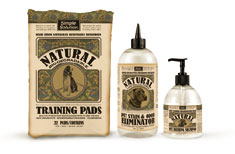 Earth conscious consumers now have an eco-friendly
choice in pet care. The Natural line of products by Simple Solution
is completely, 100% all-natural. The Biodegradable Training Pads,
used by many pet owners as an indoor potty, are 100% biodegradable
even by California's standards. They'll biodegrade faster than
an orange peel! The line also offers an all natural Pet Stain
and Odor Remover that's a great alternative to harsh chemicals
found in traditional household cleaners. Simple Solution®
Natural Pet Bathing Shampoo cleans and conditions with all natural
ingredients including, plant-based mild cleansers, Aloe Vera,
Vitamin E and Pro Vitamin B-5. Simple Solution Natural is based
on a way of life! Find Simple Solution at Petco, PetSmart or
your local pet retailer. www.simplesolution.com Earth conscious consumers now have an eco-friendly
choice in pet care. The Natural line of products by Simple Solution
is completely, 100% all-natural. The Biodegradable Training Pads,
used by many pet owners as an indoor potty, are 100% biodegradable
even by California's standards. They'll biodegrade faster than
an orange peel! The line also offers an all natural Pet Stain
and Odor Remover that's a great alternative to harsh chemicals
found in traditional household cleaners. Simple Solution®
Natural Pet Bathing Shampoo cleans and conditions with all natural
ingredients including, plant-based mild cleansers, Aloe Vera,
Vitamin E and Pro Vitamin B-5. Simple Solution Natural is based
on a way of life! Find Simple Solution at Petco, PetSmart or
your local pet retailer. www.simplesolution.com |
|
8 WAYS TO "GREEN" YOUR PET
 Can
man's best friend also be a friend to the environment? According
to the United States Humane Society, 73 million dogs and 90 million
cats currently inhabit U.S. homes, meaning household pets are
an important consumer of valuable resources in many families.
Here are eight tips on making your pet owning experience a "green"
one. Can
man's best friend also be a friend to the environment? According
to the United States Humane Society, 73 million dogs and 90 million
cats currently inhabit U.S. homes, meaning household pets are
an important consumer of valuable resources in many families.
Here are eight tips on making your pet owning experience a "green"
one.
1. Adopt Your Pet From a Local
Shelter
Pets 911 currently has a list
of over 20,000 adoptable pets from 8,000 animal shelters. All
these animals need things like food, water and vaccinations to
survive. They are not disposable, just in need of a loving home.
Before you consider buying from a pet store or breeder, visit
Pets 911
to see if your dream pet is just a shelter phone call away.
2. Help Control the Pet Population
Bob Barker's famous television
line says it best, and spaying/neutering your pets can also have
environmental impacts. According to Animal World Network, seven
puppies and kittens are born for every human, which means animal
overpopulation is a more serious issue than human overpopulation.
A neutered/spayed cat will also be less likely to suffer from
ovarian or testicular cancer, which means less resources spent
on treatment.
3. Find a Local Vet
Every time you drive your pet
for a routine check-up, you're emitting carbon dioxide into the
air. A five minute drive creates far less damage than a 45 minute
commute to the vet you started seeing when you lived five towns
away. When you move over 10 miles, consider finding a veterinarian
in your new community. Pets 911 has a database of more than 6,000
vets organized by zip code for your reference.
4. Investigate Healthy Food
Alternatives
If your family is good enough
for the latest trends of a healthy diet, why not your pet? While
organic pet food may cost a little more money, it is made with
renewable resources and no pesticides or environmentally unfriendly
fertilizers. Any extra expenses on food could easily be offset
by less medical expenses for your pet from a healthier diet.
5. Recycle Food Containers
As the #1 recycling resource
on the internet, it's only natural that Earth 911 would encourage
pet owners to practice good recycling. Whether it comes in cans,
bottles or bags, chances are your pet's food containers can be
recycled. Earth 911's recycling database can show you what facilities
in your area recycle which products.
6. Make Poop Disposal Environmentally
Friendly
All animals go to the bathroom,
and disposing of animal waste is no fun no matter what kind of
pet you own. Biodegradable bags are sold at most pet stores,
and provide an alternative to using plastic bags that are nearly
impossible to decompose. Flushing any remains down the toilet
is a smart option as well because most traditional landfills
don't lend themselves to composting.
7. Buy Your Pet Sustainable
Toys
These can range from eco-friendly
beds to hemp collars to stuffed toys made from recycled soda
bottles. Your pet may not realize that its playtime is saving
the environment, but that won't stop it from having fun with
its toys.
8. Keep Your Pet Identified
Everything involved in searching
for a lost pet takes up environmental resources. Whether it's
printing up paper flyers to post information or driving around
the neighborhood yelling your pet's name, losing a pet is an
environmentally unfriendly process. While tagging your pet can't
prevent it from getting lost, it will surely help with the retrieval.
Pets 911 has a Lost Pet
section for posting both lost and found pets.
http://www.Pets911.com
Animal Radio®
is proud to partner with Pets911! Hear about the latest Pets911
activities on-air on Animal Radio®
|
Guess how many bones are in the Dalmation mailbox
and WIN!
 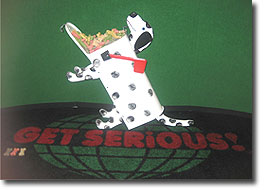 Guess how many bones
are in the mailbox and win the GET SERiOUS! SERiOUS-ly Cool Giveaway. Guess how many bones
are in the mailbox and win the GET SERiOUS! SERiOUS-ly Cool Giveaway.
Enter the GET SERiOUS!
Contest
You could win a Grand Prize Package
worth up to $700 including $100 towards the adoption of a furry-friend
from your local shelter, 1 year supply of GET SERiOUS! Extractor,
Petmate Ultra Kennel, Latka's Treats, Top Tag Pet ID and other
great prizes. Ends August 12th
|
|
G'day from Downunder...
 Kids
and pets... what does it teach? Kids
and pets... what does it teach?
With an increase in violence
here in Australia - particularly among young kids and teenagers
- we have to ask "Why?" ... What is causing needless
vandalism, domestic violence, animal cruelty and creating muggers
and murderers in our society?
Hey we know we're not fully
qualified to answer these questions - neither perhaps are you,
but we personally believe two things happen when young kids have
a pet.
The first one is - if shown
how from an early age - kids learn to respect, care and love
another being. This hopefully sets them up for a lifetime of
the same attitude towards other animals and of course people.
The second point is probably
more valuable though - because when a child is seen to mistreat
an animal whether in their care or not, it is the perfect time
for we adults to pull them back in line. To show them why it
is wrong to do what they've done.
Kindergarten and early school
teachers armed with this information could easily single out
(discreetly) young kids with obvious 'attitude' problems and
hopefully - with the right kind of professional counseling -
steer them in the right direction.
So where have we gone wrong?
- Why do we still see an increase in violence even though pet
ownership is thought to be beneficial?
Could it be high density housing? - Here in Australia we are
literally 'running out of space! - It's true - The largest continent
on earth has a very narrow coastal fringe where 95% of the population
lives.
To accommodate more and more
people, councils are now cramming as many hi-rise and multi-dwelling
apartments as possible in less and less space.
Ok - so New York and London landlords may allow animals inside...
but not here!... well with very few exceptions.
This means then that kids can't
have pets (except perhaps fish) and while we can't say for sure
that this (no pets) is the problem, it certainly makes you think.
Of course violent movies, computer
games, peer pressure and not so responsible parents have a lot
to answer for, but we think if more animals were allowed to be
kept in apartments, some of the problems kids now get into in
later life might be alleviated.
Oh - and did we mention 'civil
libertarians?' - seems a 'kick up the backside' by a parent for
misbehaviour is no longer allowed.... never did us much harm!
Anyway - all food for thought
as they say....
Feel free to comment on this or any other story we bring you
from down-under... we're reasonable pet owning people you know
:-)
Hugs for your pets
Brian & Kaye
Hear Pet Talk Radio! on Animal Radio Network
- LISTEN TO ANIMAL RADIO NETWORK NOW
- Check schedule for showtimes
| Search Animal Radio®
Network |
|
|
LISTEN TO ANIMAL RADIO NETWORK NOW
|
NETWORK PROGRAMS:
Animal Radio®
Pet Talk Radio!
Animal Wise Radio
Talk
with Your Animals
Veterinary
Minute and Animal
Minute
Voice
of the Animal
|
Currently
On-Air
Animal
Radio® Network Full-time
channel
|
LISTEN TO ANIMAL RADIO NETWORK NOW
PLATFORMS
AND PLAYERS
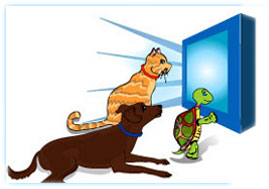 LISTEN AT WORK...all day long. Fresh animal programming 24/7.
Be sure to view our programming schedule to catch your
favorite show. LISTEN AT WORK...all day long. Fresh animal programming 24/7.
Be sure to view our programming schedule to catch your
favorite show.
 PET STORES, VETS, GROOMERS:
Would you like to broadcast Animal Radio Network in your store
or office? It's FREE and E-Z! Call 435.644.5992 to get set up.
Animal Radio Network is simulcast on the PetVision Network
throughout America to your store. PET STORES, VETS, GROOMERS:
Would you like to broadcast Animal Radio Network in your store
or office? It's FREE and E-Z! Call 435.644.5992 to get set up.
Animal Radio Network is simulcast on the PetVision Network
throughout America to your store.
  Listen to Animal
Radio Network's full-time Animal Channel ANYTIME on ANY CELL
PHONE, ANY PROVIDER. UpSnap now features Animal
Radio® Network LIVE 24/7. Listen to Animal
Radio Network's full-time Animal Channel ANYTIME on ANY CELL
PHONE, ANY PROVIDER. UpSnap now features Animal
Radio® Network LIVE 24/7.
 Get
live breaking news daily thanks to Simple Solution
NATURAL line of pet care products. Simply text "ANIMAL"
to 27627 to listen anytime FREE. (your provider's
standard rates apply). Learn more. Get
live breaking news daily thanks to Simple Solution
NATURAL line of pet care products. Simply text "ANIMAL"
to 27627 to listen anytime FREE. (your provider's
standard rates apply). Learn more.
KFXD BECOMES 95TH Animal Radio® AFFILIATE
 Animal
Radio Network™ is pleased to announce new radio affiliate
KFXD All Talk am63 Boise, Idaho to Animal Radio's growing
lineup. The Peak Broadcasting outlet airs Animal Radio®
Sundays 5-7pm. Animal
Radio® now airs on 95 multi-niche affiliates
including Los Angeles flagship KOST 103.5 FM. Animal
Radio Network™ is pleased to announce new radio affiliate
KFXD All Talk am63 Boise, Idaho to Animal Radio's growing
lineup. The Peak Broadcasting outlet airs Animal Radio®
Sundays 5-7pm. Animal
Radio® now airs on 95 multi-niche affiliates
including Los Angeles flagship KOST 103.5 FM.
Interested stations may acquire Animal Radio®
by calling 435.644.5992.
Circumstance! Not Always
What We Think!
 To
start with, let me say that I have no idea how many conversations
I have had over the years with people who can provide a long
list of why they can't have an animal or bring another one into
their family. I do know that this type of conversation takes
place very, very frequently. Some times it is when an animal
companion has passed. Some times is it when a person comes across
someone they can't get out of their mind. Some times it is when
an animal has literally wandered in off the street to their house.
And there are many more reasons for the conversation about why
people can't bring another animal into their lives. To
start with, let me say that I have no idea how many conversations
I have had over the years with people who can provide a long
list of why they can't have an animal or bring another one into
their family. I do know that this type of conversation takes
place very, very frequently. Some times it is when an animal
companion has passed. Some times is it when a person comes across
someone they can't get out of their mind. Some times it is when
an animal has literally wandered in off the street to their house.
And there are many more reasons for the conversation about why
people can't bring another animal into their lives.
The list looks something like
this - "Oh I feel so guilty that we are not home enough
to be with our animal kids. We work all day. (Fill in the name)
is probably not going to want anyone else in the family. My house
is too small for (fill in the blank). I can no longer walk them
as much as I used to. I couldn't ride a horse any more. My spouse
doesn't want another animal. I move a lot. I'm always tired when
I get home. This just isn't a good time in my life to have another
animal." And this is just a very short sample of the "whys"
people have for not bringing an animal into their lives. The
short answer for all of this is that the animals are fine with
whatever the circumstances are in your life.
You might not know this, but
animals know exactly what kind of family they will be living
with long before they come to live with you. When anyone comes
into your life, it is because at a Soul level, there has been
an agreement to meet in this life and do something together.
Some times they come for their lifetime. Some times they come
for just a short time - or anything in between. The point is
that they come to us with full knowledge and agreement at a Soul
level to live with you no matter the circumstance. They are here
to please (not because they feel like they have to, but because
there is nothing else that makes them happier), serve (again
because of choice) and teach us. All is well with them no matter
what the circumstance is. They primarily come to love us and
that can be done regardless of circumstance. Watch animals. They
naturally love. It is who they are. And, love doesn't depend
upon circumstance.
For instance, I recently had
a conversation with a woman who "came across" (meaning
she didn't go looking for a dog) a wonderful dog whom she instantly
loved and couldn't get out of her mind. The dog's eyes haunted
her. So she called me to speak with the dog, the dogs and cats
in her family and with the Soul of her partner. There was every
reason, according to the woman, why she shouldn't take this new
dog home. There was only one why she should - her heart would
simply not let go of this particular dog. We spoke to the other
animals in the family - none were very excited about another
dog. And none would go against the woman's heartfelt feeling
for this dog. Animals are so smart. They know that what's good
for one heart is, in truth, good for every other heart even if
the personality level doesn't think so. The Soul of the woman's
partner even said that although the personality level of the
partner would "pitch a fit", that was only a small
part of her and the rest of her absolutely wanted to make the
woman happy. And she also would understand that all hearts talk
the same language.
During breaks at an event this
weekend, my coordinator and I were talking about our newest family
members. We both agreed how great it was that everyone was getting
along seamlessly in their prospective households. In my household
a new Golden Retriever puppy named Candie has graced our household.
She is now 6 months. I love how she and my other Golden Retriever,
Braveheart, play with each other. She is now big enough to play
with him without him having to be careful of her as much. She
loves my kitty, Venus. She very delicately licks Venus' face.
Even though Venus is of a different species than her, Candie
thinks of Venus as her big sister. Candie follows me to the barn
so I can feed and hang out with the horses. She feels very comfortable
with the horses. She lays down on the hay I have put out for
them to eat. She loves to lick my horses especially my Paint
named Dreamweaver who she is so in love with. Candie will walk
between Dream's legs. It just thrills me to see her become an
active member of my family. I find myself saying, "Yes,
I love this about life. Thank you, Thank you, Thank you!"
My coordinator has a kitty
named Annie who is 4 years this month. Annie came to her family
when she was a year and half. This was an unexpected addition
for her family, but an expected arrival by Annie. She had been
waiting for the right circumstance to present herself. She knew
the following: her new dad did not want her, her new siblings
were a lot older than her, they including Annie all had medical
conditions and her mom had a big heart and would be willing to
do whatever it took to bring Annie home. Two and a half years
later, Annie has melted her dad's heart. Everyone has adjusted
to having a little sister. Annie hates it when her mom calls
her a baby. She tells her mom, "I am not a baby. I am a
big girl." Her mom loves when Annie plays with her big brother,
Lemonade who is 15 years. They hide then run and jump on each
other. It is great fun to watch! He is ever so gentle to not
hurt her because he knows he would be in big trouble with his
mom. The best thing about Annie is that she breathes new life
into her family. Her mom is truly grateful for that!
Animals are willing participants
in our lives no matter what the circumstance is. What fun it
is to look back and see how much you have grown as a person from
the time the animal kid first graced your life until now! Reflect
on what you have learned, where life has taken you. Give yourself
a pat on the back and say, "Yes, life is grand! Thank you!
Thank you! Thank you!"
Until next time, I'm Joy reminding
you, you can never love your animal companions too much. You
can only love them, hopefully, enough.
If you would like to
schedule a private session with Joy, call 425-867-1779 or go
to www.TalkWithYourAnimals.com.
If you are interested in being a caller on Talk with your Animals,
please email Martha@AnimalRadio.com
to make arrangements. Joy Turner is a regular Animal Radio®
correspondent. She can be heard daily. LISTEN TO ANIMAL RADIO NETWORK NOW
|
Animal Radio® made
possible by: American Anti-Vivisection
Society
 The
FDA has moved biotech companies one step closer to being able
to put milk and meat from cloned animals on your grocery store
shelves-without labels. Cloning seriously threatens animal welfare,
and you should have the choice to avoid these products! You can
help by calling on the FDA to keep cloned foods off of grocery
store shelves. Learn more at http://www.EndAnimalCloning.org The
FDA has moved biotech companies one step closer to being able
to put milk and meat from cloned animals on your grocery store
shelves-without labels. Cloning seriously threatens animal welfare,
and you should have the choice to avoid these products! You can
help by calling on the FDA to keep cloned foods off of grocery
store shelves. Learn more at http://www.EndAnimalCloning.org
Just because we can clone animals
for food, doesn't mean we should!
|
|
Voice of the Animal on Animal Radio Network
Rae Ann Kumelos Ph.D. |
Perils on the Sea - The
Dogs of Titanic
 The vessel was the largest and most luxurious
ever built. 2200 people booked passage on its maiden voyage west
across the Atlantic, and many of those passengers had with them
their dogs. Among the many distinctive appointments on this grand
floating palace was a statue of Artemis, ancient Greek goddess
of the wild and protector of animals. Prominently displayed on
the mantle in the first class lounge, the statue of Artemis meant
the dogs on board the Titanic had a special goddess looking after
them. The vessel was the largest and most luxurious
ever built. 2200 people booked passage on its maiden voyage west
across the Atlantic, and many of those passengers had with them
their dogs. Among the many distinctive appointments on this grand
floating palace was a statue of Artemis, ancient Greek goddess
of the wild and protector of animals. Prominently displayed on
the mantle in the first class lounge, the statue of Artemis meant
the dogs on board the Titanic had a special goddess looking after
them.
As the Titanic set sail from
Southampton, England on April 12, 1912, the dogs were a highly
visible part of the voyage. Both the dogs and people on Titanic
had impressive pedigrees. There was a champion French bulldog
named Gamon de Pycombe, and an Airedale named Kitty who belonged
to the John Jacob Astors. While most of the dogs stayed in shiny
brand new kennels, newlywed Helen Bishop insisted that she keep
her tiny dog, Frou Frou, with her in their first class suite.
The promenade deck of the Titanic might not have been so different
from a stroll down 5th Avenue or Rodeo Drive today, as a French
artist on board noted, that "many of the obnoxious and ostentatious
American women carry tiny dogs around with them and lead their
husbands about like pet lambs."
Every day a crewmember would
take the dogs for a stroll about the ship; this canine parade
became quite an event, in fact, seven-year old survivor Eva Hart
was so enchanted with the presence of the regal Gamon de Pycombe,
that she spent the rest of her life surrounded by French bulldogs.
The passengers enjoyed the dogs so much, that an informal dog
show was scheduled for Monday April 15th.
But as we know, that show would
never take place. When the Titanic struck the iceberg late Sunday
evening, April 14th, more than 1500 people lost their lives,
and so did all but two of the dogs. A Pomeranian, and a Pekinese
named Sun Yat Sen, were lucky enough to accompany their people,
Margaret Hayes, and Henry Sleeper Harper of Harper Publishing,
on one of the first lifeboats. Although Frou Frou was with Helen
Bishop in their cabin, Helen chose to leave her beloved dog on
the ship when it became clear there were not enough lifeboats
for all the passengers. In a heartbreaking account, Helen described
how, as she left her cabin for the last time, Frou Frou grabbed
the hem of her dress, tearing it.
As Titanic sank into the icy
Atlantic, a Mr. Norris found himself treading water to stay afloat
next to the French bulldog, Gamon de Pycombe. Later, safely aboard
the Carpathia, Mr. Norris thought he had imagined the bulldog
in the water, until another rescued passenger explained that
after the lifeboats were gone, he had made his way to the kennels
and released all of the dogs, to spare them the horror of drowning
in locked cages.
In 1986, among the wreckage
of the Titanic strewn about the ocean floor, was found the statue
of Artemis. The goddess had accompanied her beloved dogs from
the Titanic into the waiting arms of Poseidon, god of the sea.
Visit us at http://www.voiceoftheanimal.com to hear more
stories and to order CD's of Voice of the Animal programs. Copyright
2007 Voice of the Animal. Rae Ann Kumelos is a regular
Animal Radio® correspondent. She can be heard daily. LISTEN TO ANIMAL RADIO NETWORK NOW
Animal
Radio® is made possible by:
GET SERiOUS!
 - Extracts stains
& odors COMPLETELY
-in only 3 minutes! - Extracts the urine &
the pheromone -so pets aren't attracted back to re-mark! - Extracts stains
& odors COMPLETELY
-in only 3 minutes! - Extracts the urine &
the pheromone -so pets aren't attracted back to re-mark!
- Never leaves any "yellowing" behind (like
most enzyme-based cleaners) and even removes old locked-on
"yellowing" - left behind by other cleaners!
-1 bottle of GET SERiOUS! cleans as much
as 2 bottles of the competition because you only use 1/2 as much
as the others! - $AViNGS ! $AViNGS
! $AViNGS !
http://www.GetSeriousProducts.com |
|
 Email
your events to: root@AnimalRadio.com Email
your events to: root@AnimalRadio.com
New York Bird Club
Bird Walk in Central Park
Saturday, August 11th
Time: 9 am - Noon
We'll meet on the southeast
corner of 81st Street and Central Park West on the park side
entering the Park directly and taking in what wildlife may be
in evidence along the way. Dependent on what we find we'll visit
Tanner Spring, the Shakespeare Garden, pass by Belvedere Castle
and head into the Ramble. Much will depend on what we find and
where we find it. It will still be breeding season so we should
find many young birds and some late wildflowers. There's a chance
for some early migrants heading south.
Please dress comfortably and
bring water and a snack and, if possible, binoculars. If you
are new to birding, you will be given a few pointers about using
binoculars and doing birding.
Our tour guide, Randolph Schutz
has been birding since the 1980's. Trained as a pediatrician,
he quickly moved into psychiatry, then psychotherapy, and currently
works as a coach. He writes poetry, speaks French, paints watercolors,
is fascinated by the workings of the human mind, entranced by
everything living and loves birds, though when there's an interesting
plant around he'll head for that, too. He has birded extensively
around the metropolitan area, birds Central Park regularly and
frequently, and has led both formal and informal birding groups
for years. He birds in all seasons and most weathers, and while
he loves unusual birds he's been known to be hypnotized by titmice
and sparrows.
The walk is free to members;
and $5 for all others.
Rain Date: to be announced
The Animal Acres 2007 Gala
Saturday, August 25th
Animal Acres Sanctuary
Acton, CA
5:00 - 11:00pm
The Animal Acres 2007 Gala
will be held on Saturday, August 25th at the Animal Acres Sanctuary
and Compassionate Living Center in Acton, CA. The sanctuary is
located on a beautiful 26-acre hacienda-style ranch, just 40
minutes from Hollywood.
The festivities will begin at 5:00 pm with the "Cowtail
Party", where celebrity hosts, award recipients, and Gala
guests meet and mingle with the sanctuary's "guests of honor"
over 150 rescued cows, pigs, turkeys, chickens, sheep and
goats. Gala guests will then gather in the sanctuary rose
garden to enjoy a gourmet dinner sponsored by Gardenburger and
BuyKind.com. The evening's award program honors individuals and
corporations who have made outstanding contributions through
their commitment to the cause of protecting farmed animals and
promoting compassionate living choices. Awards are presented
by our celebrity hosts previous Gala presenters
include: James Cromwell, Daryl Hannah, Jorja Fox, Loretta Swit,
Thora Birch, Persia White, Linda Blair, Carol Leifer, Jane Velez-Mitchell.
All proceeds from the Gala will benefit the Animal
Acres Emergency Rescue Fund to provide needed funding
for the rescue and rehabilitation of suffering farmed animals.
Animal Acres is directed by Farm Sanctuary co-founder
Lorri Bauston, who opened the nation's first farmed animal sanctuary
in 1986. Bauston's work has been featured in numerous documentaries
and national news stories, including the Los Angeles Times,
NPR, CBS This Morning, CNN, New York Times, Wall Street Journal,
and PrimeTime Live. Bauston is considered the "pioneer"
of the farmed animal sanctuary movement which has now grown to
over 25 sanctuaries throughout the country. This year, she and
Gala supporters celebrate 21 years of rescuing and protecting
farmed animals.
Animal Acres is a non-profit animal advocacy organization
dedicated to promoting farmed animal protection through direct
rescue and shelter efforts, humane education, public outreach,
and investigative actions to prevent cruelty to farmed animals.
For more information on the organization's programs and campaigns.
| ANIMAL
RADIO®
PRODUCT REVIEW for
August |
|
     (rated 5 out of 5 paws) (rated 5 out of 5 paws)
Petmate Luxury Lounger Pet
Bed, Faux Leather
 Normally
when we receive packages here at Animal Radio® the
studio cats gather around. They are usually not interested in
what's inside the box, but the box itself. Normally
when we receive packages here at Animal Radio® the
studio cats gather around. They are usually not interested in
what's inside the box, but the box itself.
This time, we were barely able
to get the Luxury Lounger Pet Bed out of the box before one of
the studio cats jumped in it and claimed it for himself. No testing,
no trial period, just immediate pure (in this case purrrr) ecstasy.
The bed features an orthopedic
foam base and a poly filled pillow with a zippered cover that
can be easily removed for cleaning, and the faux leather earth
tone looks great in the studio. It is large enough for two of
our kitties at a time, but unfortunately, it is not large enough
for me!
http://www.Petmate.com
Send products for review
on-air and in this newsletter to: Animal Radio® Network Product Reviews, 233
East 330 North, Kanab, Utah 84741. Products may not be returned.
|
| Small Dogs, Big Hearts with
Darlene Arden |
 ASK "THE DOG EXPERT" - by Darlene Arden, Certified Animal
Behavior Consultant ASK "THE DOG EXPERT" - by Darlene Arden, Certified Animal
Behavior Consultant
Q. I've been hearing a lot
about dog fighting because of Michael Vick. Can you tell me why
people do this? What kind of person would hurt dogs like that
and what will happen to the poor dogs?
A. To know why people do this
would probably take a psychiatrist to answer the question but
I can tell you that times have certainly changed. There was a
time when sports figures were heroes making a decent living.
What is heroic about someone who gets paid an exorbitant amount
of money, thereby raising ticket prices so that the average family
can't afford to attend the event? And what about the sports figure's
behavior when he is not playing? Is this the role model you want
for children? In the case of Michael Vick, his sport is football,
a "game" in which people deliberately run into each
other and can cause physical harm. It is a "game" that
has become, in my opinion, increasingly violent on the field.
Far better for children to admire firefighters and policmen,
the people who risk their lives every day for a comparatively
small amount of money.
In this country we are innocent until proven guilty but no matter
who is responsible, the photos of those dogs removed from his
property, both dead and alive, are truly horrifying.
The surviving dogs will need
medical care, of course, and will need to be individually evaluated
by either veterinary or applied animal behaviorists or certified
animal behavior consultants to see if they can be rehabilitated.
It's the people who have trained them to fight and be mean and
have possibly bred them for these qualities. But, mainly, it
is the way they have been raised, trained and exploited by humans
that has created this nightmare for the dogs.
Dog fighting is animal cruelty,
plain and simple. It is a brutal bloodsport in which dogs fight
each other to the death for the "entertainment" of
people who bet on which dog will win. Sadly, often a breed is
blamed, like one of the "Bull" breeds. There is a saying,
"Punish the deed, not the breed."
Did you know that all serial
killers began as animal abusers? Animal abuse leads to abuse
of humans. Where you find one you are likely to find the other.
Think about that for awhile, Susan.
Rent one of the old "Our
Gang" movies and you will see the dog who was the kids'
best buddy. That dog was what would be referred to as a "Pitbull"
today. He was likely an American Staffordshire Terrier. He was
a sweet dog. I've met many such dogs. In fact, my author photo
was taken with "graduates" of the Massachusetts SPCA's
Boston Shelter. I did this deliberately to show that there are
wonderful shelter dogs across the country in need of good homes.
Except for the Pug on my lap, all of the others in the photo
are Pitbull crosses and they took turns trying to see who could
give me the most kisses during the photo shoot!
Shame on those humans who exploit
dogs! Those convicted of dog fighting should, in my opinion,
be punished to the fullest extent of the law. I only hope that
the dogs can be rehabilitated and placed in loving homes to live
out their lives in peace and harmony and sharing a loving bond
with humans instead of being used and abused by humans.
"Ask the Dog Expert"
is a regular column by Darlene Arden. This month's column features
information found in her book, "The Angell Memorial Animal
Hospital Book of Wellness and Preventive Care for Dogs,"
(McGraw-Hill), which helps you, in concert with your veterinarian,
design a wellness program based on your dog, your lifestyle and
the place where you live, and "Small Dogs, Big Hearts,"
(Howell Book House), and the newly released, "Rover, Get
Off Her Leg!" Further information may also be found on her
website: www.darlenearden.com.
Copyright 2007 by Darlene Arden. All Rights Reserved.
|
Animal Radio® made
possible by: FIDO FRIENDLY MAGAZINE
 Fido
Friendly magazine lists accommodations where you can stay with
your dog while traveling in the United States and Canada. Each
quarter, our editorial includes hotel, city and state reviews. Fido
Friendly magazine lists accommodations where you can stay with
your dog while traveling in the United States and Canada. Each
quarter, our editorial includes hotel, city and state reviews.
http://www.FidoFriendly.com
Don't miss Fido Friendly
Travel Talk exclusively on Animal Radio®
|
|
| ANIMAL
RADIO® BOOK REVIEW for August |
Animal
Radio® Book Club
     (rated 5 out of 5 paws) (rated 5 out of 5 paws)
 The Cat In Art by Stefano
Zuffi The Cat In Art by Stefano
Zuffi
Hardcover: 360 pages
Publisher: Harry
N. Abrams, Inc. (April 2007)
ISBN-10: 0810993287
ISBN-13: 978-0810993280
The Cat in Art takes you through centuries of masterpieces in
which the image of the cat is depicted. It includes Egyptian
and Classical art, the Renaissance and Baroque periods.
The author also includes detailed interpretations of these works
of art. Not only will you learn about the artists themselves,
but you will also receive a little bit of history of the cat
during these times.
This is a beautiful book you will want to display and a must
have for the cat lover! I promise you - you won't be able to
put it down
See other reviews at
AnimalRadio.com. Send books and literature for review on-air
and in this newsletter to: Animal Radio Network™ Book Reviews,
233 East 330 North, Kanab, Utah 84741. Product may not be returned.
Allow 5 weeks for review. |
Animal
Radio® made possible by: Kurgo
 Everyone loves to bring their dog in
the car with them. Kurgo has developed a line of products to
make it convenient, secure and enjoyable for you to bring Fido
on a ride. We look at things from the owner's and dog's perspective,
which has helped us develop some truly unique products for you.
Plus, the products are all made of high quality materials with
more thoughtful features than you can shake a leash at. Everyone loves to bring their dog in
the car with them. Kurgo has developed a line of products to
make it convenient, secure and enjoyable for you to bring Fido
on a ride. We look at things from the owner's and dog's perspective,
which has helped us develop some truly unique products for you.
Plus, the products are all made of high quality materials with
more thoughtful features than you can shake a leash at.
http://www.Kurgo.com |
|
| ASK THE BIRD
FOLKS with Mike O'Connor |
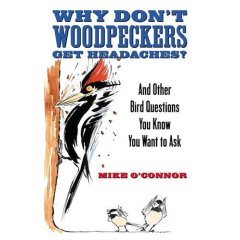 Dear Bird Folks, Dear Bird Folks,
Today I discovered a dead Blue
Jay on my front lawn. The bird was in pretty good shape, except
for being dead. As I stood there considering a possible cause
of death, I looked up and noticed the power lines running into
my house. Do you think that this Blue Jay could have landed on
one of the wires and electrocuted itself?- Diane, Brewster, MA
One minute, Diane,
I'll get to your question in
a minute, but your note reminded me of something I saw earlier
today. I drove past a local clam restaurant on my way to work
and noticed that they had just installed one of those ridiculous
bug zappers near their outdoor eating area. A bug zapper? Are
these people the only beings left in the world who haven't heard
that bug zappers do more harm than good? And that zappers actually
incinerate thousands of beneficial insects while rarely killing
mosquitoes or any other nuisance insect? Some studies indicate
they could actually spread diseases. When the bugs hit the zapper
they explode, spreading minute insect parts all around the area.
Yum! However, I'm not going to name which restaurant installed
the lame bug zapper. This restaurant is very popular, with powerful
owners. I don't want to wake up to find the head of a fried clam
at the foot of my bed.
I know it seems like I started
a bit off topic, Diane, but that little zapper rant actually
does have something to do with your question. You mentioned that
the Blue Jay you found was in "pretty good shape, except
for being dead" (cute line, by the way). Well, I'm no Dr.
Quincy, and luckily for me no one has ever mixed me up with Jack
Klugman, but I doubt the jay had a problem with your power lines.
If it had, the poor bird would have looked like those smoldering
bug zapper insects. But you are right to be concerned about power
lines. They are a problem.
 In
many ways birds benefit from power lines. We've all seen hawks
sitting high on top of utility poles searching for some furry
creature to wander out into the open. Ospreys love those big
poles to build their nests on. Each fall swallows gather on the
power lines by the hundreds before they start their trip south.
Both the poles and the wires are important resting locations
for many birds, especially in areas where trees are few. In
many ways birds benefit from power lines. We've all seen hawks
sitting high on top of utility poles searching for some furry
creature to wander out into the open. Ospreys love those big
poles to build their nests on. Each fall swallows gather on the
power lines by the hundreds before they start their trip south.
Both the poles and the wires are important resting locations
for many birds, especially in areas where trees are few.
There once was a time when
I thought the reason birds didn't get fried when they sat on
the wires was because the wires were encased in insulation, just
like the way power cords to our electric appliances are insulated.
Well, once again I was wrong. It turns out that only the power
lines around homes are insulated, but the big transmission wires
aren't protected by insulation at all. If you touched one, you'd
be toast. Am I the only one who didn't know that? The birds can
safely sit on the bare wires because they aren't grounded. So,
if I understand it right, I could jump up, grab a power line
and be fine, as long as I didn't touch the ground, a pole, a
tree branch or another wire. However, if I touched anything else
I would then complete the circuit and would instantly become
the barbecued special of the month.
Small birds, such as swallows
and jays, may not have a problem with power lines, but many large
birds aren't as lucky. Cranes, eagles, pelicans and condors top
the list of birds that we continue to lose to power lines. When
a large bird flies between wires and touches its wing tips to
two different wires at the same time, the results are bad. Every
year many of our majestic birds are killed when they accidentally
complete the circuit, including three California Condors that
all fell victim in a single week this past May.
It's not always the electricity
itself that causes problems for birds. Many birds are injured
when they simply collide with transmission wires. Snow, rain,
fog and darkness all play a role in causing a whole host of birds
to collide with the lines. In some critical locations pressure
has been put on the power companies to either bury their lines,
hang markers on the lines to make them more visible or at least
insulate them. In many ways saving the birds is in the companies'
best interest. They may or may not care about the birds, but
they do care if their equipment is damaged and service is interrupted.
Even power companies don't like to listen to irate customers
who have lost power and are missing the latest showing of American
Idol.
Sorry about your jay, Diane,
but I doubt your power lines had anything to do with it. Even
though the power lines weren't the villains in this case, they
still are a major concern for birds. Unfortunately, electricity
is a necessary evil. There isn't much we could do without it.
How else could we get insect parts to explode and fall into our
fried clams?
Mike O'Connor is the owner
of the Bird Watcher's General Store on Cape Cod, which opened
in 1983 as one of the first stores in the United States dedicated
solely to birding. His column, Ask the Bird Folks, appears weekly
in The Cape Codder, The Register, The Harwich Oracle, and The
Upper Cape Codder newspapers, and his writing was included in
the Best American Science and Nature Writing 2004. Copyright
2007 by Mike O'Connor. All Rights Reserved. http://www.BirdWatchersGeneralStore.com
Animal
Radio® made possible by: DryFur
 The Amazing DRYFUR, designed to be inserted
into pet carriers, crates, kennels and cages while pet is traveling
or being transported by plane, train or auto. Super Absorbent
Polymers trap wetness from pet in a gel-like state deep below
the surface of the pad to keep pet completely DRY and comfortable.
The insulated rigid core provides stability to the carrier and
helps holds the insert in place (no bunching up) providing a
stable surface for the pet to sit, stand and turn around on.
Dry Fur pet carrier inserts are completely disposable, just use
until soiled and toss away. Sold in 2pks or complete Pet Airline
Kits. Your Pet will arrive with Dry Fur...We Guarantee it! The Amazing DRYFUR, designed to be inserted
into pet carriers, crates, kennels and cages while pet is traveling
or being transported by plane, train or auto. Super Absorbent
Polymers trap wetness from pet in a gel-like state deep below
the surface of the pad to keep pet completely DRY and comfortable.
The insulated rigid core provides stability to the carrier and
helps holds the insert in place (no bunching up) providing a
stable surface for the pet to sit, stand and turn around on.
Dry Fur pet carrier inserts are completely disposable, just use
until soiled and toss away. Sold in 2pks or complete Pet Airline
Kits. Your Pet will arrive with Dry Fur...We Guarantee it!
http://www.DryFur.com |
|
| PAWS
UP FOR PETS with Arden
Moore |
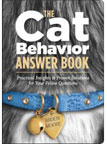 "Arden
Moore Unleashed for a Pet-Friendly America" Tour "Arden
Moore Unleashed for a Pet-Friendly America" Tour
Baffled by your beagle? Perplexed
by your Persian? Are you at your wit's end in trying to get your
dog to stop acting like a roto-tiller on your vegetable garden
or in attempting to prevent your cat from pawing you awake two
hours before your alarm clock is set to ring?
Relax. I'm here to help. In fact, I am traveling coast to coast
on a mission: restoring harmony in your pet household. As a pet
author, editor and animal behavior consultant, I am the logical
target for questions from people frustrated or simply bewildered
as to why their pets do what they do. It has become apparent
that Americans tend to know more about reality shows and the
latest Paris Hilton escapade than they do about feline and canine
behavior.
The sad reality is that the No. 1 killer of cats and dogs under
age 3 is not cancer or car collisions. It is preventable behavior
problems. Frustrated owners seeing no other option
surrender healthy young pets to shelters. If they are not adopted
or transferred to rescue groups, these pets are euthanized. Many
people than must cope with feelings of guilt.
For
the past few years, I have kept a file on real questions from
real people about real pet problems and my answers. The
result is the release of my latest books: The Cat Behavior
Answer Book and The Dog Behavior Answer Book.
My publisher, Storey Books,
has dispatched me this month on a national book tour appropriately
called: "Arden Moore Unleashed for a Pet-Friendly America."
The tour kicked off at St. Hubert's Animal Welfare Center in
Madison, N.J. at an ice cream social where people and their dogs
enjoyed sweet, cool treats. The tour ends at a pet-friendly bookstore
called Warwick's in La Jolla, Calif. on Aug. 30. The complete
tour schedule is posted at the end of this column.
My quest is to provide positive, workable tactics for people
so that cats and dogs can enjoy safe and loving homes. Let me
share with you a few conversations I've had with people at my
tour stops:
- A couple in Madison, N.J.
have a 16-year-old cat who is suddenly defecating outside the
litter box. In gathering details, I learned that their cat is
also showing signs of arthritis. The litter box is located in
the basement. Solution: provide a litter box on the main floor
level so this senior cat doesn't have to endure pain in his aging
joints to go to the bathroom. Also, book an appointment with
their veterinarian to rule out any possible medical cause.
- A couple in Newburyport, Mass.
adore their Border collie mix except in the evening when
they are together on the couch to watch television. The otherwise
friendly dog growls at them when he is on the couch. My recommendation:
make the couch off limits to this bossy Border collie and provide
him with a comfy dog bed in the living room. Usher him to the
new doggy digs with a cheese-filled Kong or synthetic hollow
bone. Have this dog sit and wait politely before giving him the
treat.
- A woman in Milford, N.H. is
contending with a spirited 8-month-old kitten who enjoys leaping
from the floor and nipping this woman's cheek. It's a feline
version of "tag you're it" but it is painful
and medically, dangerous. Cat bites can result in major
infections and should be treated. In this case, I suggested she
consider getting this kitten a feline playmate and providing
sturdy, stable high places like a cat tree or wide window
ledges for this cat to perch and play. In addition, I taught
her how to read her kitten's body language so that she can exit
before the kitten is ready to leap.
Face it we love our pets
even when they puzzle us. They not only offer companionship
and unconditional love, but they also are proving to be good
for our mental and physical health. The true healing power of
pets is only just being identified by top scientists and research
hospitals.
If you find yourself stymied by your pet's behavior, I urge you
to seek professional help from groups like the International Association of Animal Behavior
Consultants of which I am a member. For serious issues, please
consult the Animal
Behavior Society for a list of certified-applied animal behaviorists.
I invite you to learn more
by visiting my tour blog on my website: www.ardenmoore.com.
Arden Moore Unleashed for
a Pet-Friendly America Tour Schedule:
July 25 St. Hubert's Animal Welfare Center, Madison, New
Jersey, 6:30 p.m.
July 27 Jabberwocky Bookshop, Newburyport, Massachusetts,
7 p.m.
July 28 The Toadstool Bookshop, Milford, New Hampshire,
2 p.m.
July 30 Borders, 32nd Street and Second Avenue, New York
City, 7 p.m.
July 31 Manhattan Cat Specialists Clinic, New York City,
3-6 p.m.
Aug. 1 Northshire Bookstore, Manchester, Vermont, 7 p.m.
Aug. 2 Porter Square Books, Cambridge, Massachusetts, 7
p.m.
Aug. 11 Chicago Anti-Cruelty Society, 2:30 p.m.
Aug. 12 Ruff Haus Pets, 1 p.m., in Chicago
Aug. 14 Humane Society of Missouri, St. Louis, Missouri,
6:30 p.m.
Aug. 16 Boulder Book Store, Boulder, Colorado, 7:30 p.m.
Aug. 18 The Petropolitan, Dallas, Texas, noon
Aug. 22 Oceanside, California location to be announced
Aug. 26 Elliott Bay Books, Seattle, Washington, 2 p.m.
Aug. 27 Powell's Books, Beaverton, Oregon, 7:30 p.m.
Aug. 28 Muttropolis, Tucson, Arizona
Aug. 29 Bones n Scones, Palm Springs, California
Aug. 30 Warwick's, La Jolla, California
Hear Arden Moore on
Animal Radio® August 11th. She made it onto Jay Leno's Headlines!
You've arrived Arden!
Animal
Radio® special
correspondent Arden Moore is the editor of Catnip, the managing
editor of Fido Friendly and the author of 17 books on cats and
dogs. She shares her Oceanside, Calif. home with dogs, Chipper
and Cleo and cats, Callie and Murphy. She can be reached through
her Web site: http://www.ArdenMoore.com
|
 Have you heard Animal Radio®
Network Lately? Have you heard Animal Radio®
Network Lately?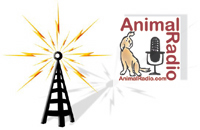
So many ways to listen!
Website: http://AnimalRadio.com
Toll-Free Studio Line is: 1.866.405.8405
- View
list of AM-FM RADIO STATIONS that air Animal Radio in your city.
Including
KOST 103.5 and KBIG 104.3 in Los Angeles
Website: http://www.AnimalRadio.com
Toll-Free Studio Line is: 1.866.405.8405
|
|
| For
Pet's Sake with Karen
Lee Stevens |
 The
Power of Purring The
Power of Purring
I'm getting to that age where I'm starting to think about
hot flashes, hormones and hysterectomies. If that weren't enough,
apparently I also need to worry about losing it-bone density,
that is.
So, armed with a physician's
prescription for a bone density scan and a check for $250 (insurance
doesn't cover the procedure, thank you very much), I headed over
to our local Radiology Center for my very expensive, very painless
x-ray. A few days later, the results were in: my spine is in
perfect shape; my hips, well, not so much. I have some thinning
of the hip bones, called "osteopenia." My bones were
going through calcium faster than a Hummer (an automobile my
mom affectionately refers to as a "Bummer") goes through
a gallon of gasoline. Never mind that I had broken my bank account
in order to attain this news; I might actually fracture a hip
if I didn't put the brakes on my bone loss.
What's a pre-menopausal, calcium-challenged
gal to do? First of all, I knew I had to-pardon the pun-bone
up on my knowledge of bone loss. I learned that, like most things
in life, an ounce of prevention really is worth a pound of cure.
Too late for that, in my case. It was time to start popping pills.
Expensive pills. But wait, it turns out I might be able to ditch
the doctor and the drugs altogether and pick up a purring cat
instead.
Scientists at the Fauna Communications
Research Institute in North Carolina suggest that one of the
reasons why a cat purrs is because it helps to heal and strengthen
their bones and organs. And here's the really neat part: a purring
cat may help heal humans as well. Talk about your good vibrations!
Now I consider myself to be, um, hip, to the latest scientific
research, but this was a new one on me. Still, I liked what I
was hearing and wanted to know more.
In a telephone conversation
with Fauna's president, Elizabeth von Muggenthaler, I learned
that she has conducted studies on dozens of wild and domestic
cats since 2001 and has recorded the purrs of five cat species:
the cheetah, puma, serval, ocelot and the domestic cat. von Muggenthaler's
research, in conjunction with NASA and others, suggests that
low frequencies, at low intensity (such as the purr), are therapeutic.
These frequencies can aid in increasing bone mass, the healing
of fractures and repair of joints, and pain relief. In addition,
tendons and muscles are strengthened, swelling is reduced, and
dyspnea (breathlessness) is alleviated.
"Purring is not just a
content mechanism," von Muggenthaler says, "its survival
oriented."
All cats, she adds, exhibit
strong purr frequencies that fall within 20 Hz. and 200 Hz. At
a range of 25-100 Hz., bones are strengthened and fractures heal
more quickly. Vibration at these frequencies has been proven
by other researchers to be helpful in the fight against osteodiseases
such as osteoporosis in humans.
With this new knowledge, that old physician's proverb: "Take
two aspirin and call me in the morning," just might have
to be updated to read: "Take one purring cat and call me
in the morning." I just hope that by the time I need a prescription
for a purr-meister, I won't require a hearing aid to help amplify
the purring sound.
Karen Lee Stevens, Founder
and President of ALL
FOR ANIMALS, Inc. Although she's not quite ready for dentures
or Depends, Karen has recently started wearing glasses to read
the tiny typeface on prescription pill bottles. Send her an email
message (in large print, please) to: karen@allforanimals.com.
Animal Minute on
Animal Radio Network
with Britt Savage |
Cats Go On The Longest Taxi
Ride
 Do
you find it hard to put your animal on a plane cross-country?
Well, so did Bob and Betty Matas of New York when they moved
to Phoenix, Arizona. Do
you find it hard to put your animal on a plane cross-country?
Well, so did Bob and Betty Matas of New York when they moved
to Phoenix, Arizona.
Instead, they found a cab driver,
Douglas Guldeniz, who agreed to make the trek. The driver took
the Matas's along with their two cats, Cleopatra and Pretty Face
for a 2,500 mile drive from New York to Arizona, for a fee of
$3,000, plus gas meals and lodging. Good thing the driver drove
a SUV hybrid-electric vehicle to save on fuel!
Einstein - The Trained Goldfish
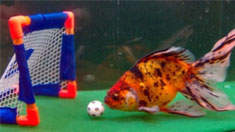 Studies are
showing that the common goldfish may be a lot smarter than we
thought. Nine-year-old Kyle Pomerleau agrees. He won Albert Einstein
the goldfish at a school fair and soon noticed that the fish
would react to him whenever he came near the tank. Studies are
showing that the common goldfish may be a lot smarter than we
thought. Nine-year-old Kyle Pomerleau agrees. He won Albert Einstein
the goldfish at a school fair and soon noticed that the fish
would react to him whenever he came near the tank.
Kyle and his dad decided that
they would try to train the goldfish to do something. They first
bought a finger soccer kit from a dollar store and rewarded Albert
with food every time he swam near the net. As soon as Albert
got the net trick, they added a ball. Soon Albert was trained
to push the ball into the goal for a treat. The father and son
training team have heard from so many people eager to train their
own fish, they've now started selling fish training manuals from
their Fish
School website. They say it takes about five or six training
sessions a day for about three weeks to teach most goldfish how
to swim through a hoop.
Britt Savage is a regular
Animal
Radio® correspondent. She can be heard daily. LISTEN TO ANIMAL RADIO NETWORK NOW
Email us at: YourVoice@AnimalRadio.com
Anna Drummond writes:
In the July Newsletter, you discuss the downside of declawing,
yet your laser surgery article talks about doing laser declawing.
While the vet writing the article says it's less traumatic than
regular declaw, the four veterinarians I talked to said there
is no difference. You're still cutting through bone, tendons,
muscle and nerves -- you're just using laser instead of metal.
Also, the vets who buy the laser equipment need to pay for it
so of course they are going to say laser declaw is better than
reg. declaw. I hope in the next issue you'll clear this up for
readers, because I'm sure that some people reading both articles
will think they can now go ahead and declaw with laser declawing,
that it's less horrible for patients, which it is not.
-Anna Drummond
President Pet
Adoption League
Anna- Thanks for your comment.
The Animal Radio® newsletter is a compilation of many
authors and experts, sometimes with differing opinions. It is
Animal Radio's stance that declawing is 100% unacceptable under
any circumstances, and IS NOT the last option EVER. Some Doctors
think this is an acceptable procedure if done with laser. Declawing
is illegal in most advanced countries.
|



 Lucie Arnaz, the daughter
of Lucille Ball and Desi Arnaz, discusses her childhood pets and
life with her famous parents.
Lucie Arnaz, the daughter
of Lucille Ball and Desi Arnaz, discusses her childhood pets and
life with her famous parents. THE
NEW YORK TIMES, RICHMOND, Va., - One of the men indicted with
Michael Vick on federal dogfighting charges pleaded guilty Monday
and has agreed to help prosecutors make their case.
THE
NEW YORK TIMES, RICHMOND, Va., - One of the men indicted with
Michael Vick on federal dogfighting charges pleaded guilty Monday
and has agreed to help prosecutors make their case. Wendie Malick was a presenter at the 21st Genesis
Awards, which is an annual event to honor outstanding individuals
in the major media for raising awareness of animal issues presented
by The Humane Society of the United States.
Wendie Malick was a presenter at the 21st Genesis
Awards, which is an annual event to honor outstanding individuals
in the major media for raising awareness of animal issues presented
by The Humane Society of the United States. This year's award, which took place
on March 24th at the Beverly Hilton in Beverly Hills, California.
The full ceremony is being re-broadcast on AmericanLife TV.
This year's award, which took place
on March 24th at the Beverly Hilton in Beverly Hills, California.
The full ceremony is being re-broadcast on AmericanLife TV. Broadway
and TV star John Tartaglia ("Avenue Q," "Johnny
and the Sprites") has volunteered to spread the word about
pet adoptions and is now a spokesperson for The Humane Society
of the United States' Proud 2 Adopt campaign. The New
York-based actor shares his home with four of his own shelter-adopted
pets.
Broadway
and TV star John Tartaglia ("Avenue Q," "Johnny
and the Sprites") has volunteered to spread the word about
pet adoptions and is now a spokesperson for The Humane Society
of the United States' Proud 2 Adopt campaign. The New
York-based actor shares his home with four of his own shelter-adopted
pets. Tartaglia
stated, "I believe that there is no organization as powerful
and knowledgeable about animal issues as The HSUS and it's an
honor to be linked with them on this project. I consider my own
dog Dora and cats, Sebastian, Mia and Keisha all from shelters
to be part of my family, and I am a proud dad to have them
in my life."
Tartaglia
stated, "I believe that there is no organization as powerful
and knowledgeable about animal issues as The HSUS and it's an
honor to be linked with them on this project. I consider my own
dog Dora and cats, Sebastian, Mia and Keisha all from shelters
to be part of my family, and I am a proud dad to have them
in my life."

 Lucie
Arnaz was one of the first members of Actors and Others for Animals
when they opened their doors. This comes as no surprise, as she
is the daughter of Lucille Ball and Desi Arnaz, who were big
animal lovers themselves. Lucie grew up around all types of animals,
from rabbit and ducks and once even had a boa constrictor. Her
father, Desi Arnaz, once owned and operated a thoroughbred breeding
farm called Corona Breeding Farm of thoroughbred horses.
Lucie
Arnaz was one of the first members of Actors and Others for Animals
when they opened their doors. This comes as no surprise, as she
is the daughter of Lucille Ball and Desi Arnaz, who were big
animal lovers themselves. Lucie grew up around all types of animals,
from rabbit and ducks and once even had a boa constrictor. Her
father, Desi Arnaz, once owned and operated a thoroughbred breeding
farm called Corona Breeding Farm of thoroughbred horses. Dogs are the pets that travelers
bring along most often, according to the Travel Industry Association.
It estimates that 29 million travelers have taken a pet with
them at least once in the past three years. The group said 78
percent of those people (about 22.6 million) took dogs, while
feline travelers were a very distant second. Cat owners made
up 15 percent of the pet-toting public (about 4.4 million).
Dogs are the pets that travelers
bring along most often, according to the Travel Industry Association.
It estimates that 29 million travelers have taken a pet with
them at least once in the past three years. The group said 78
percent of those people (about 22.6 million) took dogs, while
feline travelers were a very distant second. Cat owners made
up 15 percent of the pet-toting public (about 4.4 million). 10.
10.
 8. The
8. The
 5.The
5.The
 4.
4.
 With it's pet-friendly gondola
and 2 dogs per person ratio, Telluride Colorado makes our Fido
Friendly top ten list coming in at number 1. No matter the season,
the resort town of Telluride rolls out the welcome mat for you
and your dog. With puppy parking stations located throughout
town, you can leash Fido up with some of his new best friends
while you run errands or dine. There is a dog park in town and
you will see several well-behaved pooches walking off-leash with
their guardians. The whole town is Fido-friendly and there are
too many Fido-friendly hotels to mention. Just take my word for
it, this is a travel destination for you and your dog you won't
want to miss.
With it's pet-friendly gondola
and 2 dogs per person ratio, Telluride Colorado makes our Fido
Friendly top ten list coming in at number 1. No matter the season,
the resort town of Telluride rolls out the welcome mat for you
and your dog. With puppy parking stations located throughout
town, you can leash Fido up with some of his new best friends
while you run errands or dine. There is a dog park in town and
you will see several well-behaved pooches walking off-leash with
their guardians. The whole town is Fido-friendly and there are
too many Fido-friendly hotels to mention. Just take my word for
it, this is a travel destination for you and your dog you won't
want to miss. Transdermal delivery of medications
to veterinary patients is becoming increasingly popular. The
transdermal gel is simply rubbed into the pet's inner ear, delivering
an active agent or a combination thereof in a controlled form.
The transdermal gel technology controls the delivery of the active
agent over periods of time ranging from 12 to 24 hours. The extent
of the controlled release window enables a once-a-day application.
Transdermal delivery of medications
to veterinary patients is becoming increasingly popular. The
transdermal gel is simply rubbed into the pet's inner ear, delivering
an active agent or a combination thereof in a controlled form.
The transdermal gel technology controls the delivery of the active
agent over periods of time ranging from 12 to 24 hours. The extent
of the controlled release window enables a once-a-day application. There
are also "
There
are also " You've probably heard of therapy
dogs and cats, and even perhaps horses and pigs. But what about
a Kangaroo? Well, residents of the Silverado Senior Living Community
have the pleasure of visits from Elliott, a six-month old baby
Kangaroo.
You've probably heard of therapy
dogs and cats, and even perhaps horses and pigs. But what about
a Kangaroo? Well, residents of the Silverado Senior Living Community
have the pleasure of visits from Elliott, a six-month old baby
Kangaroo. It
has been proven that animals of all types can have large health
benefits. Dr. Marty Becker, author of The Healing Power of
Pets states that "there is actually a biochemical event
that happens when they come in contact, a biochemical spa treatment
of sorts and that "it lowers blood pressure and elevates
the mood."
It
has been proven that animals of all types can have large health
benefits. Dr. Marty Becker, author of The Healing Power of
Pets states that "there is actually a biochemical event
that happens when they come in contact, a biochemical spa treatment
of sorts and that "it lowers blood pressure and elevates
the mood." Armed with a mantra of "Just
Do It", Christopher Ameruoso has carved himself a unique
and successful niche in the Hollywood Hills where dreams are
made and stars are born. Gaining access to some of Hollywood's
most sought-after stars, armed only with an artistic eye an his
camera, Ameruoso has become a self-made photographer of Pets
and the stars that own them. He has been photographing actors,
actresses, and models since 1998, and has released a best selling
pet book "Pets and Their Celebrities".
Armed with a mantra of "Just
Do It", Christopher Ameruoso has carved himself a unique
and successful niche in the Hollywood Hills where dreams are
made and stars are born. Gaining access to some of Hollywood's
most sought-after stars, armed only with an artistic eye an his
camera, Ameruoso has become a self-made photographer of Pets
and the stars that own them. He has been photographing actors,
actresses, and models since 1998, and has released a best selling
pet book "Pets and Their Celebrities". Throughout
the course of his career Christopher's work has been featured
in People magazine, In Style, Smoke, Star, US Weekly, The New
York Times, Daily News, The NY Post, and The LA Times to name
a few. In fact, People Magazine broke tradition and printed a
unique black and white montage of some of Christopher's select
pieces.
Throughout
the course of his career Christopher's work has been featured
in People magazine, In Style, Smoke, Star, US Weekly, The New
York Times, Daily News, The NY Post, and The LA Times to name
a few. In fact, People Magazine broke tradition and printed a
unique black and white montage of some of Christopher's select
pieces. My first dog, a German Shepherd
named Buddy, was a beautiful, intelligent, perfect companion.
That is for one slight problem. He turned into a lunatic during
thunderstorms. And I don't mean just huddling in a corner, but
knocking over full-sized sofas in an attempt to get his 90-pound
frame behind one,
My first dog, a German Shepherd
named Buddy, was a beautiful, intelligent, perfect companion.
That is for one slight problem. He turned into a lunatic during
thunderstorms. And I don't mean just huddling in a corner, but
knocking over full-sized sofas in an attempt to get his 90-pound
frame behind one, Mike Fry, Animal Ark Animal Shelter
and Host of Animal Wise Radio with Dr. Linda Wolf
Mike Fry, Animal Ark Animal Shelter
and Host of Animal Wise Radio with Dr. Linda Wolf Moving to Aspen in 1992, Seth
Sachson was hired as the director of the shelter in 1993, and
in 1994 took over the contract to operate the shelter. In the
past 9 years, Seth has turned the shelter into a happy, healthy
atmosphere for animals and people alike.
Moving to Aspen in 1992, Seth
Sachson was hired as the director of the shelter in 1993, and
in 1994 took over the contract to operate the shelter. In the
past 9 years, Seth has turned the shelter into a happy, healthy
atmosphere for animals and people alike. Get
ready for spring by protecting your dog and your family
against intestinal worm infections! Did you know that eggs
and larvae that infect dogs can survive in the environment for
months even in extreme winter weather conditions? And that
those same parasites can also infect humans? Why take chances?
Make intestinal deworming an important part of your dog's routine
health care with Safe-Guard® Canine Dewormer a safe
and effective way to eliminate and prevent the major intestinal
worms that can infect dogs all year round. Just sprinkle it on
your dog's food twice a year, for complete peace of mind!
Get
ready for spring by protecting your dog and your family
against intestinal worm infections! Did you know that eggs
and larvae that infect dogs can survive in the environment for
months even in extreme winter weather conditions? And that
those same parasites can also infect humans? Why take chances?
Make intestinal deworming an important part of your dog's routine
health care with Safe-Guard® Canine Dewormer a safe
and effective way to eliminate and prevent the major intestinal
worms that can infect dogs all year round. Just sprinkle it on
your dog's food twice a year, for complete peace of mind! Rabies.
Almost everyone knows how scary this disease is- because it is
fatal to both people and pets. And this year is unusual as we
are seeing more cases earlier than normal. Most people believe
that rabies is well under control due to vaccinations and regulations.
But what you may not know is that every spring and summer, we
see an emergence of rabies. Worse yet exposure to rabies can
happen in your own backyard.
Rabies.
Almost everyone knows how scary this disease is- because it is
fatal to both people and pets. And this year is unusual as we
are seeing more cases earlier than normal. Most people believe
that rabies is well under control due to vaccinations and regulations.
But what you may not know is that every spring and summer, we
see an emergence of rabies. Worse yet exposure to rabies can
happen in your own backyard. I'm not sure what info you will
need, so I will tell you as much as I can. I have 2 male indoor
cats that I have had since Dec. 06 and both are fixed and get
along great. They are happy and very comfortable at home, lovable,
and are in great health. The one I have an issue with is Raider.
I'm not sure what info you will
need, so I will tell you as much as I can. I have 2 male indoor
cats that I have had since Dec. 06 and both are fixed and get
along great. They are happy and very comfortable at home, lovable,
and are in great health. The one I have an issue with is Raider. Earth conscious consumers now have an eco-friendly
choice in pet care. The Natural line of products by Simple Solution
is completely, 100% all-natural. The Biodegradable Training Pads,
used by many pet owners as an indoor potty, are 100% biodegradable
even by California's standards. They'll biodegrade faster than
an orange peel! The line also offers an all natural Pet Stain
and Odor Remover that's a great alternative to harsh chemicals
found in traditional household cleaners. Simple Solution®
Natural Pet Bathing Shampoo cleans and conditions with all natural
ingredients including, plant-based mild cleansers, Aloe Vera,
Vitamin E and Pro Vitamin B-5. Simple Solution Natural is based
on a way of life! Find Simple Solution at Petco, PetSmart or
your local pet retailer.
Earth conscious consumers now have an eco-friendly
choice in pet care. The Natural line of products by Simple Solution
is completely, 100% all-natural. The Biodegradable Training Pads,
used by many pet owners as an indoor potty, are 100% biodegradable
even by California's standards. They'll biodegrade faster than
an orange peel! The line also offers an all natural Pet Stain
and Odor Remover that's a great alternative to harsh chemicals
found in traditional household cleaners. Simple Solution®
Natural Pet Bathing Shampoo cleans and conditions with all natural
ingredients including, plant-based mild cleansers, Aloe Vera,
Vitamin E and Pro Vitamin B-5. Simple Solution Natural is based
on a way of life! Find Simple Solution at Petco, PetSmart or
your local pet retailer.  Can
man's best friend also be a friend to the environment? According
to the United States Humane Society, 73 million dogs and 90 million
cats currently inhabit U.S. homes, meaning household pets are
an important consumer of valuable resources in many families.
Here are eight tips on making your pet owning experience a "green"
one.
Can
man's best friend also be a friend to the environment? According
to the United States Humane Society, 73 million dogs and 90 million
cats currently inhabit U.S. homes, meaning household pets are
an important consumer of valuable resources in many families.
Here are eight tips on making your pet owning experience a "green"
one.

 Guess how many bones
are in the mailbox and win the GET SERiOUS! SERiOUS-ly Cool Giveaway.
Guess how many bones
are in the mailbox and win the GET SERiOUS! SERiOUS-ly Cool Giveaway. Kids
and pets... what does it teach?
Kids
and pets... what does it teach? PET STORES, VETS, GROOMERS:
Would you like to broadcast Animal Radio Network in your store
or office? It's FREE and E-Z! Call 435.644.5992 to get set up.
Animal Radio Network is simulcast on the PetVision Network
throughout America to your store.
PET STORES, VETS, GROOMERS:
Would you like to broadcast Animal Radio Network in your store
or office? It's FREE and E-Z! Call 435.644.5992 to get set up.
Animal Radio Network is simulcast on the PetVision Network
throughout America to your store.
 Animal
Radio Network™ is pleased to announce new radio affiliate
KFXD All Talk am63 Boise, Idaho to Animal Radio's growing
lineup. The Peak Broadcasting outlet airs Animal Radio®
Sundays 5-7pm. Animal
Radio® now airs on 95 multi-niche affiliates
including Los Angeles flagship KOST 103.5 FM.
Animal
Radio Network™ is pleased to announce new radio affiliate
KFXD All Talk am63 Boise, Idaho to Animal Radio's growing
lineup. The Peak Broadcasting outlet airs Animal Radio®
Sundays 5-7pm. Animal
Radio® now airs on 95 multi-niche affiliates
including Los Angeles flagship KOST 103.5 FM. To
start with, let me say that I have no idea how many conversations
I have had over the years with people who can provide a long
list of why they can't have an animal or bring another one into
their family. I do know that this type of conversation takes
place very, very frequently. Some times it is when an animal
companion has passed. Some times is it when a person comes across
someone they can't get out of their mind. Some times it is when
an animal has literally wandered in off the street to their house.
And there are many more reasons for the conversation about why
people can't bring another animal into their lives.
To
start with, let me say that I have no idea how many conversations
I have had over the years with people who can provide a long
list of why they can't have an animal or bring another one into
their family. I do know that this type of conversation takes
place very, very frequently. Some times it is when an animal
companion has passed. Some times is it when a person comes across
someone they can't get out of their mind. Some times it is when
an animal has literally wandered in off the street to their house.
And there are many more reasons for the conversation about why
people can't bring another animal into their lives. The vessel was the largest and most luxurious
ever built. 2200 people booked passage on its maiden voyage west
across the Atlantic, and many of those passengers had with them
their dogs. Among the many distinctive appointments on this grand
floating palace was a statue of Artemis, ancient Greek goddess
of the wild and protector of animals. Prominently displayed on
the mantle in the first class lounge, the statue of Artemis meant
the dogs on board the Titanic had a special goddess looking after
them.
The vessel was the largest and most luxurious
ever built. 2200 people booked passage on its maiden voyage west
across the Atlantic, and many of those passengers had with them
their dogs. Among the many distinctive appointments on this grand
floating palace was a statue of Artemis, ancient Greek goddess
of the wild and protector of animals. Prominently displayed on
the mantle in the first class lounge, the statue of Artemis meant
the dogs on board the Titanic had a special goddess looking after
them. Email
your events to:
Email
your events to:  Normally
when we receive packages here at Animal Radio® the
studio cats gather around. They are usually not interested in
what's inside the box, but the box itself.
Normally
when we receive packages here at Animal Radio® the
studio cats gather around. They are usually not interested in
what's inside the box, but the box itself.
 Fido
Friendly magazine lists accommodations where you can stay with
your dog while traveling in the United States and Canada. Each
quarter, our editorial includes hotel, city and state reviews.
Fido
Friendly magazine lists accommodations where you can stay with
your dog while traveling in the United States and Canada. Each
quarter, our editorial includes hotel, city and state reviews. The Cat In Art by Stefano
Zuffi
The Cat In Art by Stefano
Zuffi Everyone loves to bring their dog in
the car with them. Kurgo has developed a line of products to
make it convenient, secure and enjoyable for you to bring Fido
on a ride. We look at things from the owner's and dog's perspective,
which has helped us develop some truly unique products for you.
Plus, the products are all made of high quality materials with
more thoughtful features than you can shake a leash at.
Everyone loves to bring their dog in
the car with them. Kurgo has developed a line of products to
make it convenient, secure and enjoyable for you to bring Fido
on a ride. We look at things from the owner's and dog's perspective,
which has helped us develop some truly unique products for you.
Plus, the products are all made of high quality materials with
more thoughtful features than you can shake a leash at. Dear Bird Folks,
Dear Bird Folks,
 In
many ways birds benefit from power lines. We've all seen hawks
sitting high on top of utility poles searching for some furry
creature to wander out into the open. Ospreys love those big
poles to build their nests on. Each fall swallows gather on the
power lines by the hundreds before they start their trip south.
Both the poles and the wires are important resting locations
for many birds, especially in areas where trees are few.
In
many ways birds benefit from power lines. We've all seen hawks
sitting high on top of utility poles searching for some furry
creature to wander out into the open. Ospreys love those big
poles to build their nests on. Each fall swallows gather on the
power lines by the hundreds before they start their trip south.
Both the poles and the wires are important resting locations
for many birds, especially in areas where trees are few. The Amazing DRYFUR, designed to be inserted
into pet carriers, crates, kennels and cages while pet is traveling
or being transported by plane, train or auto. Super Absorbent
Polymers trap wetness from pet in a gel-like state deep below
the surface of the pad to keep pet completely DRY and comfortable.
The insulated rigid core provides stability to the carrier and
helps holds the insert in place (no bunching up) providing a
stable surface for the pet to sit, stand and turn around on.
Dry Fur pet carrier inserts are completely disposable, just use
until soiled and toss away. Sold in 2pks or complete Pet Airline
Kits. Your Pet will arrive with Dry Fur...We Guarantee it!
The Amazing DRYFUR, designed to be inserted
into pet carriers, crates, kennels and cages while pet is traveling
or being transported by plane, train or auto. Super Absorbent
Polymers trap wetness from pet in a gel-like state deep below
the surface of the pad to keep pet completely DRY and comfortable.
The insulated rigid core provides stability to the carrier and
helps holds the insert in place (no bunching up) providing a
stable surface for the pet to sit, stand and turn around on.
Dry Fur pet carrier inserts are completely disposable, just use
until soiled and toss away. Sold in 2pks or complete Pet Airline
Kits. Your Pet will arrive with Dry Fur...We Guarantee it! "Arden
Moore Unleashed for a Pet-Friendly America" Tour
"Arden
Moore Unleashed for a Pet-Friendly America" Tour
 The
Power of Purring
The
Power of Purring Do
you find it hard to put your animal on a plane cross-country?
Well, so did Bob and Betty Matas of New York when they moved
to Phoenix, Arizona.
Do
you find it hard to put your animal on a plane cross-country?
Well, so did Bob and Betty Matas of New York when they moved
to Phoenix, Arizona.
 Studies are
showing that the common goldfish may be a lot smarter than we
thought. Nine-year-old Kyle Pomerleau agrees. He won Albert Einstein
the goldfish at a school fair and soon noticed that the fish
would react to him whenever he came near the tank.
Studies are
showing that the common goldfish may be a lot smarter than we
thought. Nine-year-old Kyle Pomerleau agrees. He won Albert Einstein
the goldfish at a school fair and soon noticed that the fish
would react to him whenever he came near the tank. FINAL POOP
FINAL POOP
 *
ADVERTISING OPPORTUNITIES for 2006 ANIMAL RADIO®
PROGRAMMING available. Call 435.644.5992. Animal Radio® Network, according to Arbitron radio
ratings, is the most-listened-to animal programming in the United
States. We have 250,000 Average-Quarter-Hour listeners - which
translates to an audience of two-million weekly in ninety-plus
cities. Our affiliate stations are top performers including KOST
103.5 and KBIG 104.3 in Los Angeles. Animal Radio® is the most concentrated radio audience
of targeted animal lovers anywhere! Please contact us for aggressive
and omnipotent branding and cultivating customer loyalty. Advertising
opportunities in this newsletter are also available. 38,000 subscribers
are reading this message right now!
*
ADVERTISING OPPORTUNITIES for 2006 ANIMAL RADIO®
PROGRAMMING available. Call 435.644.5992. Animal Radio® Network, according to Arbitron radio
ratings, is the most-listened-to animal programming in the United
States. We have 250,000 Average-Quarter-Hour listeners - which
translates to an audience of two-million weekly in ninety-plus
cities. Our affiliate stations are top performers including KOST
103.5 and KBIG 104.3 in Los Angeles. Animal Radio® is the most concentrated radio audience
of targeted animal lovers anywhere! Please contact us for aggressive
and omnipotent branding and cultivating customer loyalty. Advertising
opportunities in this newsletter are also available. 38,000 subscribers
are reading this message right now! *
If you're a RADIO PROGRAMMER and would like to air ANIMAL
RADIO® - call 435-644-5992 to get all the information
you need to begin broadcasting America's number one animal talk
show geared to listeners that like to have FUN! Animal Radio® programming is FREE for your station
- and delivered via Satellite (Jones and ABC/NY Starguide) or
Compact Disc or MP3 every week.
*
If you're a RADIO PROGRAMMER and would like to air ANIMAL
RADIO® - call 435-644-5992 to get all the information
you need to begin broadcasting America's number one animal talk
show geared to listeners that like to have FUN! Animal Radio® programming is FREE for your station
- and delivered via Satellite (Jones and ABC/NY Starguide) or
Compact Disc or MP3 every week.